Acer orporated DMZ628 Smart HandHeld User Manual lqZest plus Z628 T08 UM region date EN
Acer Incorporated Smart HandHeld lqZest plus Z628 T08 UM region date EN
User Manual
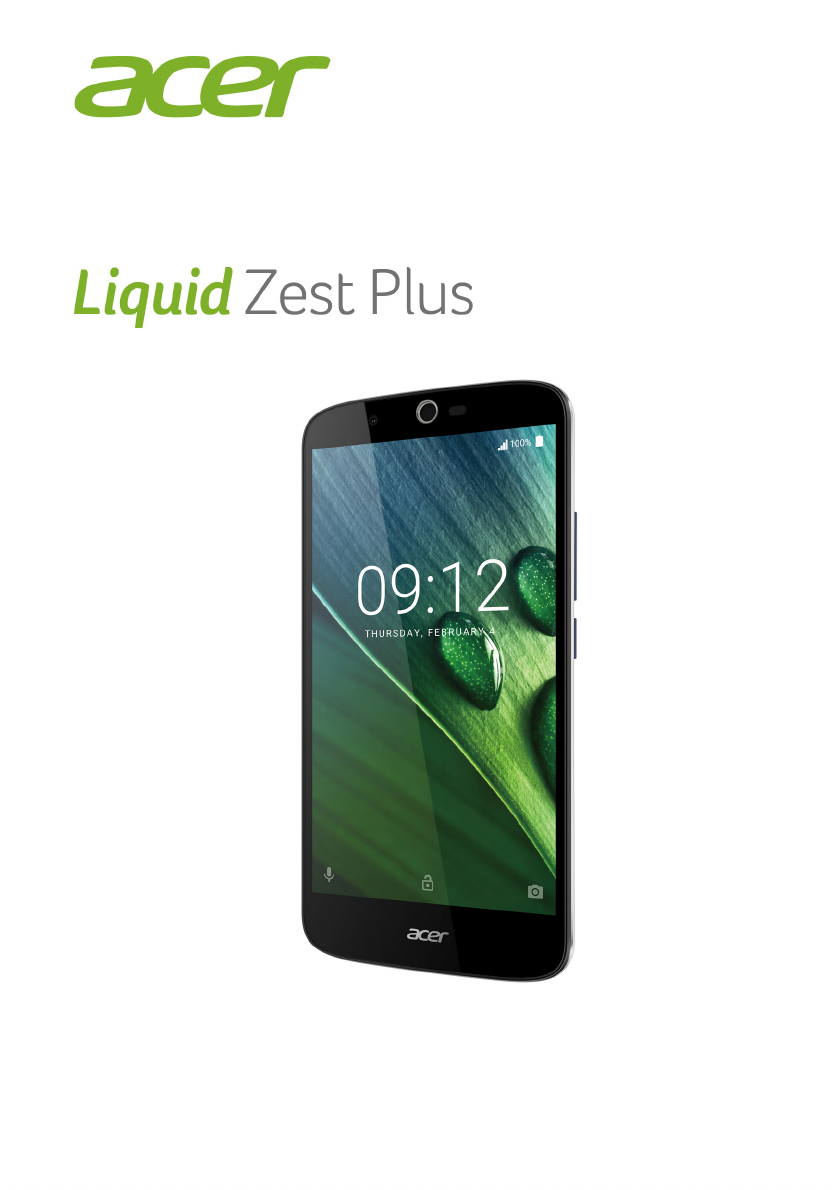
User’s Manual

2 -
© 2016 All Rights Reserved
Acer Liquid Zest Plus User’s Manual
Model: T08
This revision: May 2016
Sign up for an Acer ID and enjoy great benefits
Open the Acer Portal app from the Start screen to sign up for an Acer
ID or sign in if you already have an Acer ID.
There are three great reasons for you to get an Acer ID:
• Create your own connected world.
• Get the latest updates, offers, and product information.
• Register your device for quick, personalized customer support.
For more information, please visit the AcerCloud website:
www.acer.com/byoc-start
Important
This manual contains proprietary information that is protected by
copyright laws. The information contained in this manual is subject to
change without notice. Images provided herein are for reference only
and may contain information or features that do not apply to your
computer. Acer Group shall not be liable for technical or editorial errors
or omissions contained in this manual.
Acer Liquid Zest Plus smartphone
Model number: _______________________________________________
Serial number: _______________________________________________
Date of purchase: ____________________________________________
Place of purchase: ____________________________________________
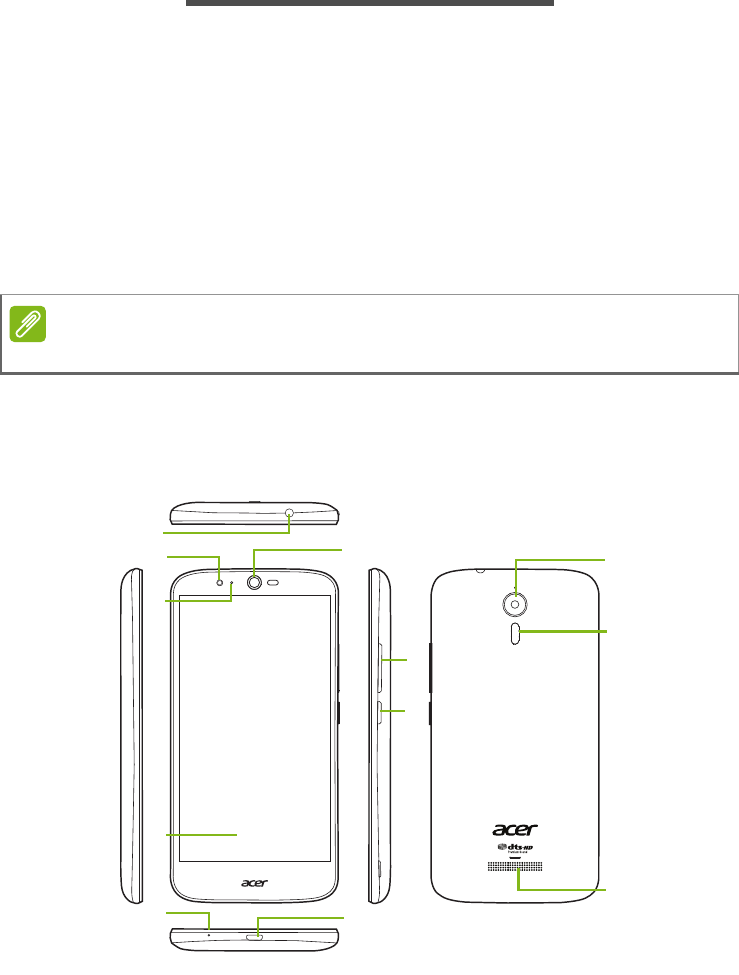
Setting up - 5
SETTING UP
Unpacking your phone
Your new phone comes packed in a protective box. Carefully unpack
the box and remove the contents. If any of the following items is
missing or damaged, contact your dealer immediately:
• Your new Acer smartphone
• USB cable
• AC adapter
• Headset
Getting to know your phone
Views
14
8
2
11
12
10
9
7
6
3
5
Note
In-box content varies depending on country and region.
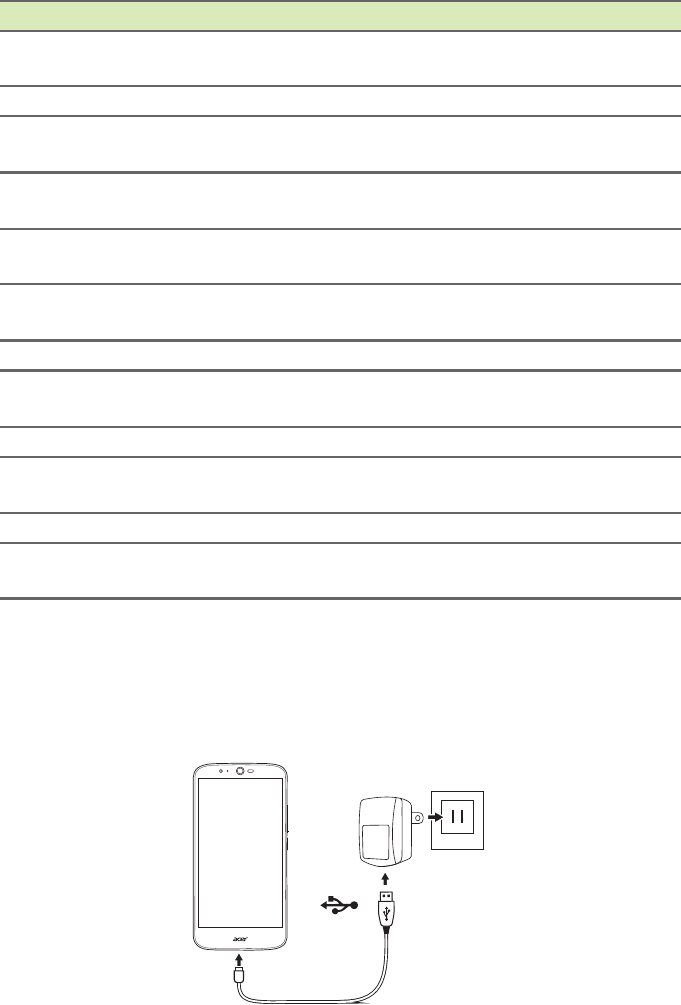
6 - Setting up
Charging the battery
For initial use, you need to charge your phone for three hours. After
that you can recharge the battery as needed.
Connect the provided USB cable to the USB connector on your phone.
No. Item Description
13.5 mm headphone
jack Connects to stereo headphones.
2 Front-facing camera For video calls or taking selfies.
3Status LED Indicates a new message or the phone’s
power status.
4 Phone speaker Emits audio from your phone; suitable for
holding to your ear.
5Touchscreen For viewing content from your phone or
entering data.
6 Microphone For picking up audio while making a phone
calls.
7 Micro USB port For connecting to a PC or a charger.
8Volume up/down
buttons Increase or decrease the audio volume.
9 Power button Turns the phone on or off.
10 Camera A camera for taking high-resolution
images.
11 Flash LED flash for camera.
12 Handsfree speaker Emits audio from your phone; suitable for
making handsfree calls.
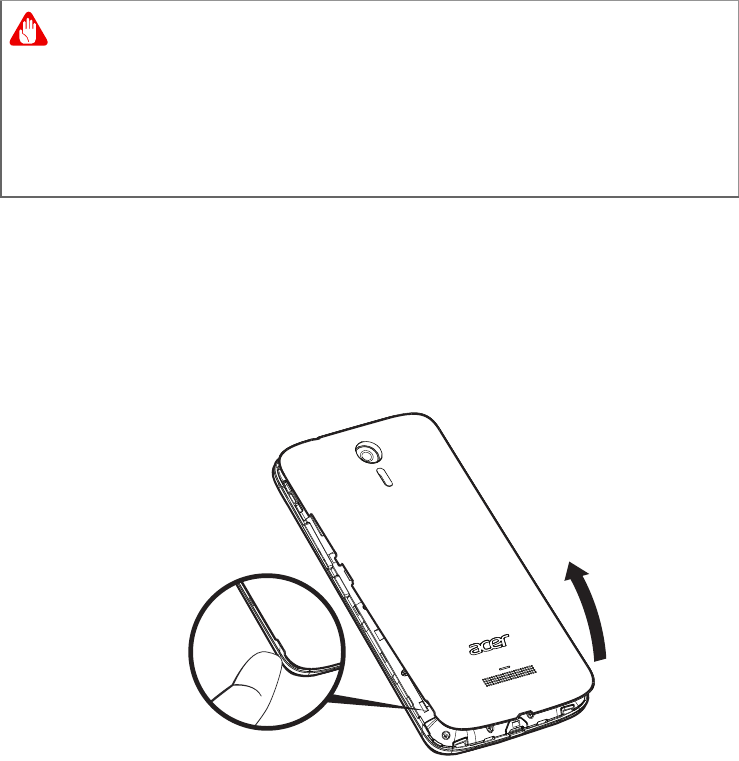
Setting up - 7
Quick charging
Your phone, USB cable and AC adapter support quick charging.
Setting up for the first time
Inserting the SIM cards and microSD card
1. Turn off the phone by pressing and holding the power button.
2. Insert your fingernail into the notch located at the bottom of the
phone and remove the cover.
Warning
Please only use the AC adapter and USB cable provided with your
phone. If you change the cable and adapter, please ensure they support
quick charging.
Quick charge technology uses a higher voltage and current than most
USB chargers, there is a risk of over-heating and fire if a non-qualified
USB cable is used.
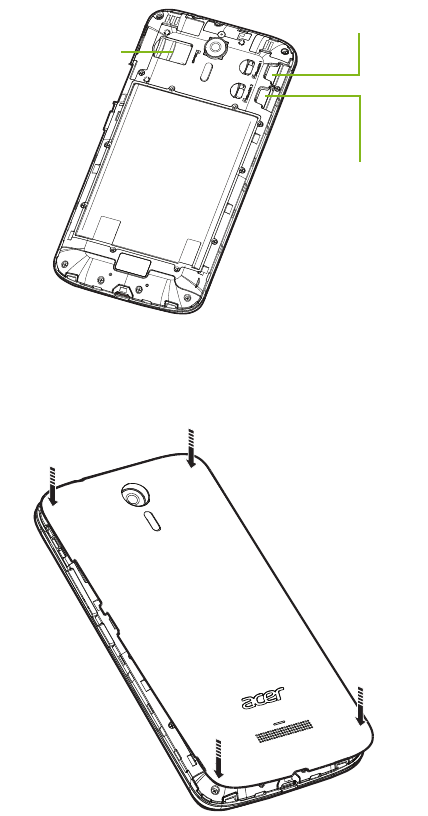
8 - Setting up
3. Insert the SIM and microSD cards as shown.
* Your phone may be equipped with one or two SIM slots depending on model.
4. Replace the cover by aligning the tabs on the cover into the slots on
the phone. Gently press the cover until it snaps in place.
SIM card lock
Your phone may come with a SIM card lock, i.e., you will only be able
to use the SIM card provided by your network operator.
To cancel the SIM lock, contact your network provider.
microSD card
Micro SIM 2
(optional*)
Micro SIM 1

Using your phone - 9
USING YOUR PHONE
Turning on for the first time
To turn on your phone for the first time, press and hold the power
button until the screen turns on. You will then be asked to configure
some settings before you can use your phone.
Follow the onscreen instructions to complete setup.
Sign in to or create a Google account
If you have internet access, your phone allows you to synchronize
information with a Google account.
You may create or sign in to an existing Google account, which will be
used to synchronize your contact list, email, calendar and other
information. Open the Apps list and then tap Settings > Accounts >
Add account. Tap the type of account you want to add (for example
Google, Acer, or Acer BYOC). You will need internet access to
complete the synchronization process. You can create and easily
access multiple accounts from your phone, including multiple Google
accounts.
Entering your PIN
When you install a SIM card for the first time, you may need to enter a
PIN using the onscreen number pad.
Activating a new SIM card
If you are using your SIM card for the first time, it may require
activation. Contact your network operator for details on how to do this.
Important
Depending on your settings, you may be required to enter your PIN
each time you switch on the phone function.
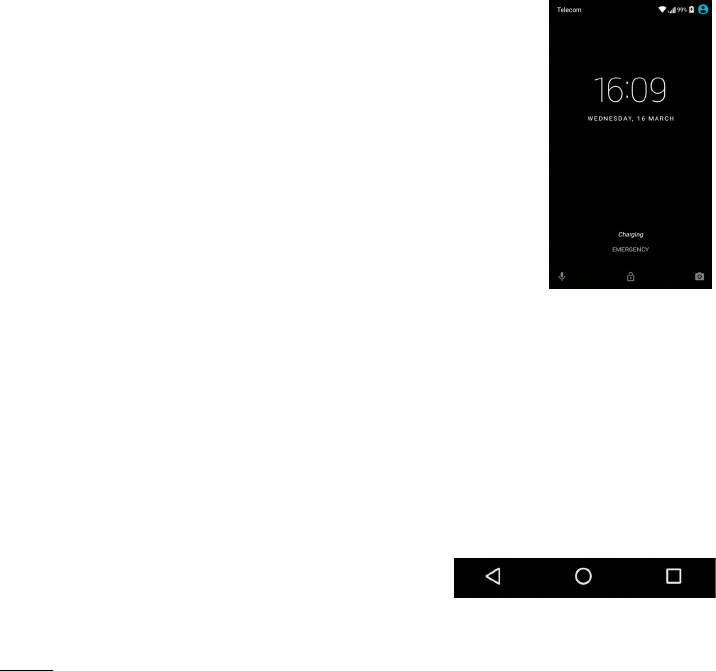
10 - Using your phone
Locking your phone
If you will not use your phone for a while, briefly press the power
button to lock access. This saves power and ensures your phone
does not unintentionally use any services. Your phone will lock
automatically if it is not used for one minute.
Waking your phone
If the screen is off and the phone does not react to
any taps on the screen, then it has been locked
and is in sleep mode.
Press the power button to wake your phone.
Unlock your phone by sliding your finger upwards
across the screen.
There are three icons at the bottom of the lock
screen (from left to right): Voice search, lock, and
camera. Place your finger on an icon and swipe
upwards to unlock the screen and launch the
associated app (if applicable) directly.
If there are notifications displayed on the lock screen, you can swipe
downwards to view the notifications.
For additional security, you may set an unlock PIN, password or
pattern, a set of dots that must be touched in the correct order to
access the phone. Open the Apps list and then tap Settings >
Security > Screen lock. If you forget your unlock pattern, please
refer to Security on page 55.
Navigating through menus and options
To navigate through menus and options,
there are three icons at the bottom of the
screen.
Back
Tap this icon to go to the previous page, or to go up one level in a
menu.
Back Home Overview
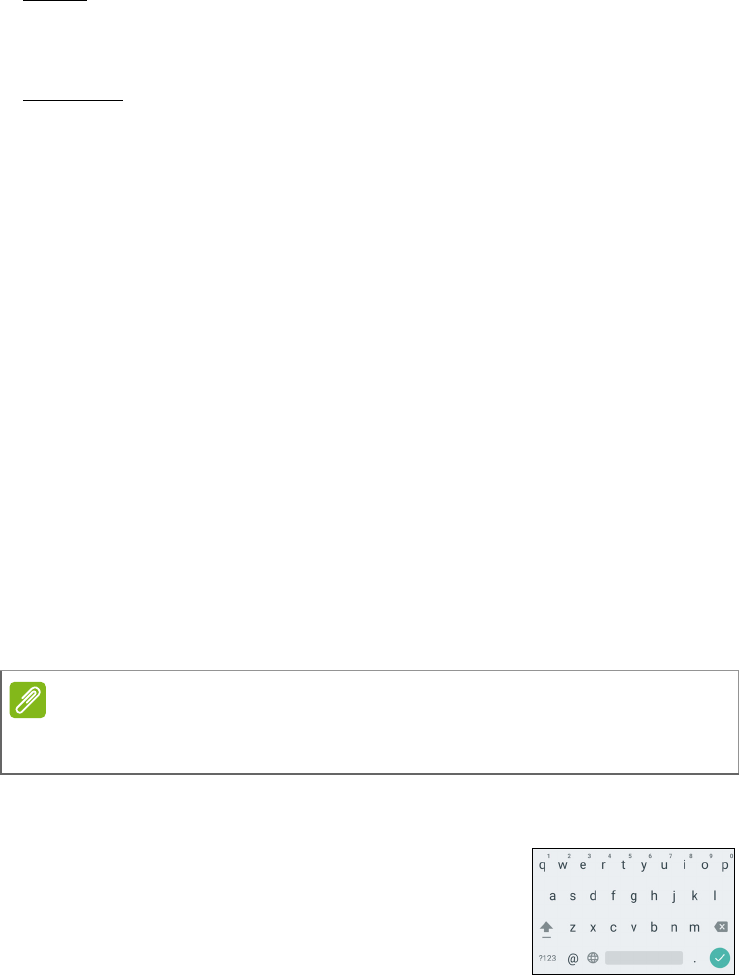
Using your phone - 11
Home
Tap this icon to go directly to the Home screen. Tap and hold this icon
to open Google Now or Search.
Overview
Tap this icon to see recently opened apps in your phone’s Overview
screen. Tap an app to open it. Tap anywhere on the screen to return
to the Home screen. See Multitasking on page 19.
Using the touchscreen
Your phone uses a touchscreen for selecting items and entering
information. Use your finger to tap the screen.
Tap: Touch the screen once to open items and select options.
Swipe: Quickly swipe your finger across the screen to switch screens
or open lists of options or information.
Drag: Hold your finger on the screen and drag across the screen to
select text and images.
Tap and hold: Tap and hold an item to see a list of actions available
for that item. On the pop-up menu that appears, tap the action you
want to perform.
Scroll: To scroll up or down the screen, simply drag your finger up or
down the screen in the direction that you want to scroll.
Onscreen keyboards
Google keyboard
This is a onscreen keyboard that allows you to
enter text. Tap and hold a key with numbers at
the top to select alternative characters, such as
letters with accents.
Note
The keyboard layout varies slightly, depending on the application and
information that is required.

12 - Using your phone
Tap the ?123 key to see numbers and special characters, and then
tap the =\< key to see even more.
If you have set up more than one language, the world key appears
next to the space bar. Tap this key to quickly toggle between multiple
input languages, or tap and hold the space bar to open the language/
keyboard selection window. The keyboard layout changes according
to the selected language.
Predictive text
In most apps, Google keyboard provides predictive text input for the
browser. As you tap the letters of a word, a selection of words are
displayed above the keyboard that continue the sequence of letters
tapped, or are a close match allowing for errors. The word list
changes after every key press. If the word you need is displayed, tap
on it to insert it into your text.
Text assistance
The Google keyboard has various features that assist you to enter
correct text. In the Apps list, tap Settings > Language & input. Then
tap Google Keyboard to see a list of settings you can adjust.
Adding an extra language
If you need to enter text in more than one language and/or alphabet
you can add languages to the Google keyboard.
1. Tap Settings > Language & input > Google Keyboard.
2. Tap the toggle switch next to Use system language to turn it off.
3. Scroll through the list of available languages to select those that you
wish to add to the keyboard by tapping the toggle switch to turn the
languages on or off.
Changing the text input method
You can change the keyboard or language from Settings as follows.
1. Open the Apps list.
2. Tap Settings > Language & input then under Keyboards & input
methods tap Current Keyboard > CHOOSE KEYBOARDS.
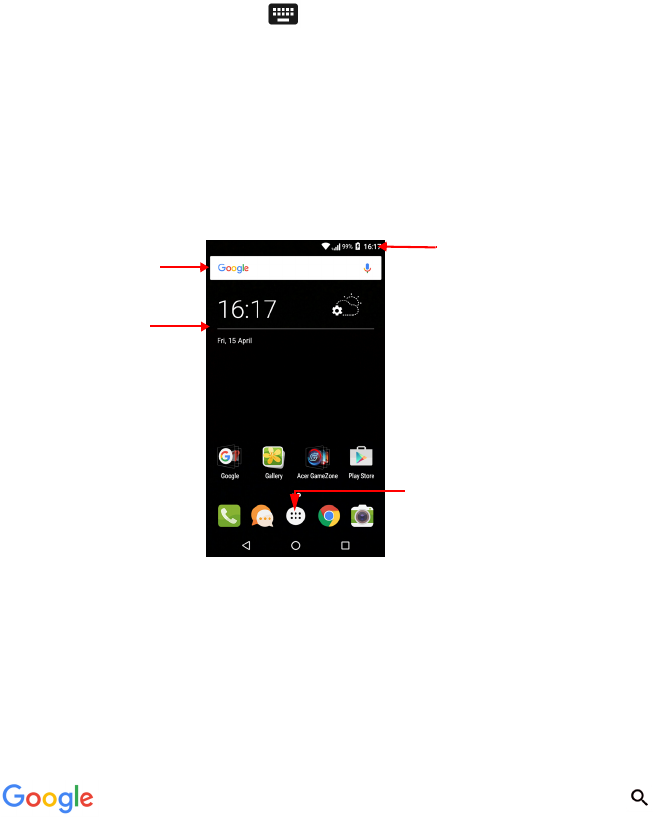
Using your phone - 13
3. Toggle the switch next to the available keyboards to turn input
methods or keyboards on or off, then tap Back.
4. If your preferred keyboard is not selected, tap Current Keyboard >
[preferred keyboard] to set the default keyboard.
Alternatively, if you have already set up more than one language or
installed multiple keyboards you can change the input method by
tapping the keyboard icon at the bottom of the screen, and then
tapping your preferred input method.
The Home screen
The Home screen gives you quick access to information and simple
controls with widgets or shortcuts. These display information such as
the time and weather, or provide additional controls and direct access
to apps and other frequently used features of your phone.
At the bottom of the screen is the Favorites tray which displays default
apps. Tap an icon to open the app. Tap the Apps list icon in the
middle of the Favorites tray to view your apps. To change apps, see
Changing Favorites tray icons on page 17.
Search
To search for apps, files or for information on the internet, tap the
icon. Simply enter the text you want to find and tap or
tap one of the suggestions, apps or files shown in the list.
Time and Status
Application (Apps) list
Search
Widgets
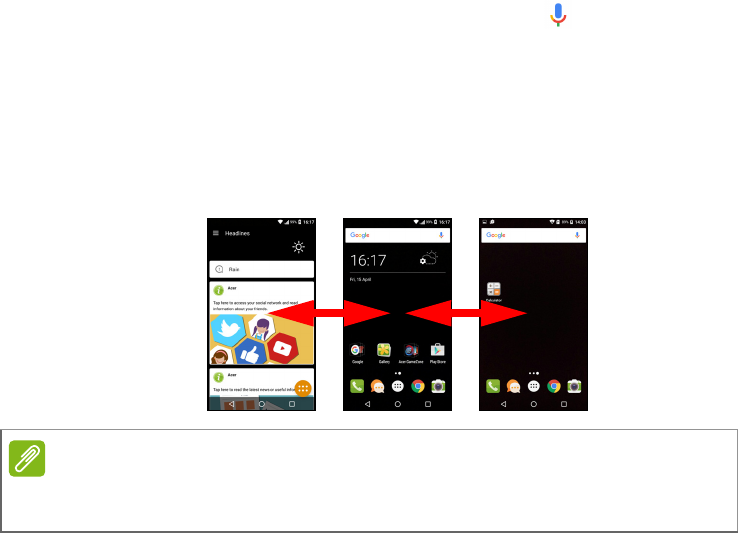
14 - Using your phone
In order to search or browse the internet, you must be connected to a
cellular data (if available) or wireless network. See Going online on
page 31.
Voice search
If voice search is available, tap the microphone and speak your
search request. See Voice search on page 33.
The extended Home screen
The Home screen extends to either side of the screen, giving you
more room to add icons, widgets or features. To view the extended
screen, slide your finger to the left or right.
Personalizing the Home screen
You may personalize your Home screen by adding or removing app
shortcuts or widgets, and by changing the wallpaper.
Note
Extended screens to the right are only available if you have added content to
the right of the Home screen.

Using your phone - 15
Adding shortcuts to the Home screen
To add app shortcuts to the Home screen, tap the
Apps list icon in the bottom-center of the Home
screen. Tap and hold the icon for the selected app.
The Apps list will close and the Home screen will
appear. Move the icon to the desired position on
the Home screen and remove your finger.
Adding Widgets to the Home screen
Tap and hold any area of the Home screen that
does not have an icon or Widget already. Tap
WIDGETS to see small apps and links (such as
custom shortcuts, contacts or bookmarks) that you
can add to a Home screen. Widgets are small apps
that display constantly-updated information or
quick shortcuts to apps or special functions.
To move an app or widget to the Home screen, tap
and hold an item until it is selected. The Home
screen will open. Drag the item to any free area on
the screen. To view information about the app or
widget, drag it to the icon at the top of the screen.
To move the item to a different Home screen, drag
it to the side of the screen, the Home screen will
switch to the screen in that direction. Release the
item when it is positioned correctly.
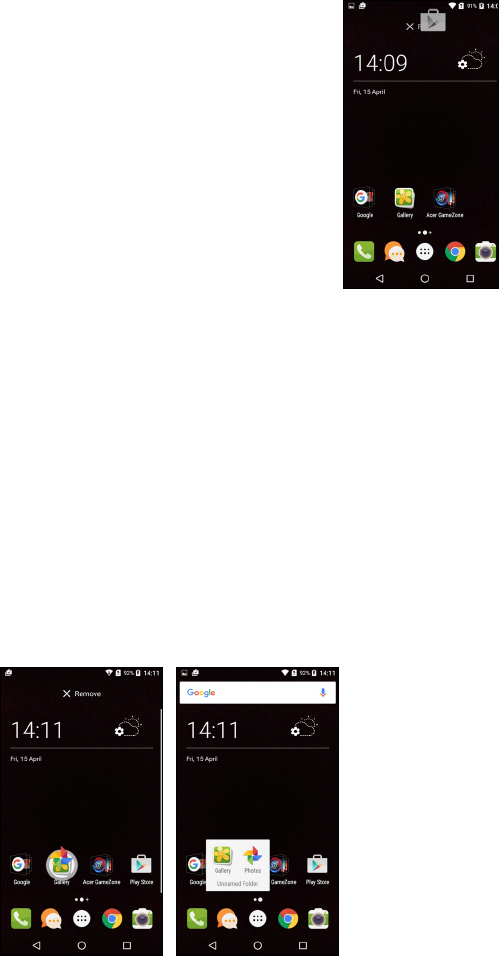
16 - Using your phone
Removing Widgets or shortcuts from the Home screen
To remove a shortcut or widget from the Home
screen, tap and drag it to Remove at the top of the
screen.
Resizing widgets
Some widgets can be resized. As soon as you place a widget on the
Home screen, you can resize it by dragging the corners.
To resize a widget that is already on the Home screen, tap and hold
the widget. Once the Remove icon appears, release the widget. If the
widget is resizable, you will be able to drag the sides of the widget to
resize it.
Adding or removing folders
You can also add folders to your Home screen. To create a new folder
drag and drop an app icon onto another app icon in the Home screen.
This will create an Unnamed Folder. Tap the folder icon and then tap
the name of the folder to rename it.
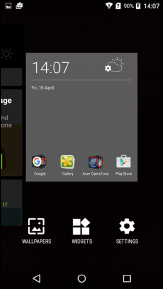
Using your phone - 17
To delete an app shortcut from a folder, tap on the folder icon to
display the apps inside and then tap and hold the app icon that you
want to remove. Drag and drop the icon on Remove that will appear
at the top of the screen.
To delete a folder, tap and hold on the folder and then drag and drop
the folder on Remove that will appear at the top of the screen.
Changing Favorites tray icons
You can set icons for installed apps in the Favorites tray. Open the
Apps list and find the app you want to add. Tap and hold the icon,
then drag it to any open position in the Favorites tray. Dragging the
new app to an existing Favorites tray icon will create a folder for both
icons.
To remove an icon from the Favorites tray, tap and hold the icon to
select it. Either drag the icon to a different location outside the
Favorites tray or to Remove at the top of the screen.
Changing the wallpaper
Tap and hold any area of the Home screen that
does not have an icon or Widget already, tap
WALLPAPERS.
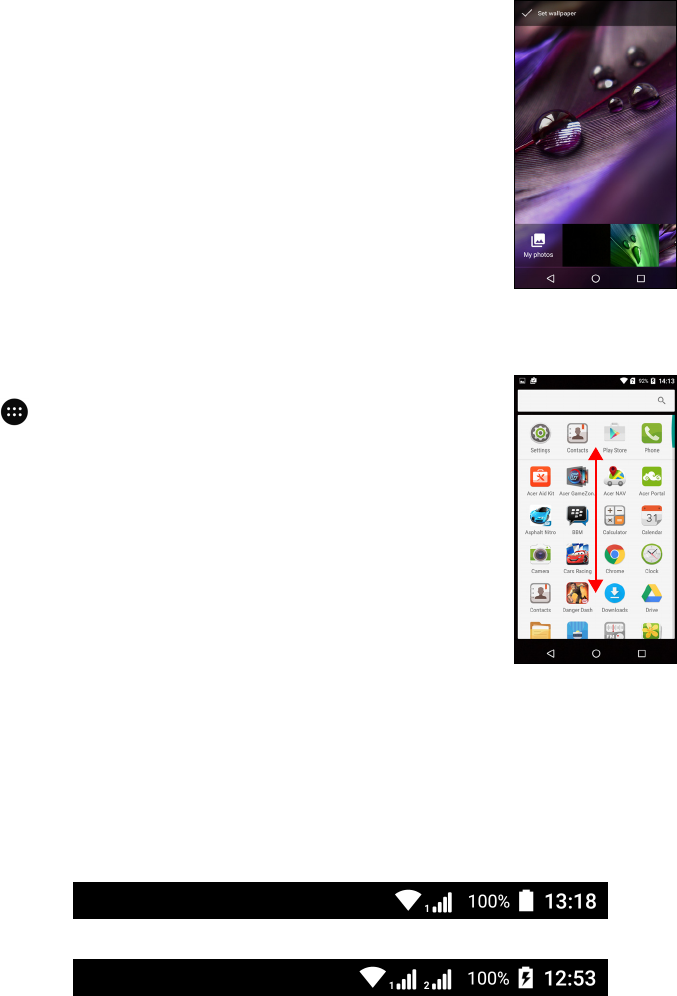
18 - Using your phone
A selection of wallpapers are shown in a bar at the
bottom of the screen; drag the bar left or right to
see more options. If you wish to use a wallpaper
other than those shown, tap My Photos in the
lower-left corner and select and image from Gallery
or Photos.
Tap on the thumbnail to select the wallpaper you
wish to use, then tap Set wallpaper.
The Apps list
To access the Apps list, on the Home screen tap
in the center of the Favorites tray.
Apps are displayed in alphabetical order, with the
four most-recently used apps at the top of the
menu. Swipe up or down to see the complete list of
apps.
Notification and status area
Notification and status icons are shown at the top of the screen. The
top-right area displays a variety of status information, such as Wi-Fi
connectivity, signal strength, battery status, and time. The top-left
area displays event icons, such as a new message.
• Single-SIM models:
• Dual-SIM models:

Using your phone - 19
Swipe down from the Notification bar to display any
notifications.
Swipe down twice or once with two fingers to open
Quick Settings, which allows you to quickly adjust
selected settings or turn features on or off.
Multitasking
You can have multiple apps open at the same time.
To open a new app, tap the home icon to return to
the Home screen, then start the new app. Tap the
Overview icon to quickly navigate back and forth
between previously-opened apps.
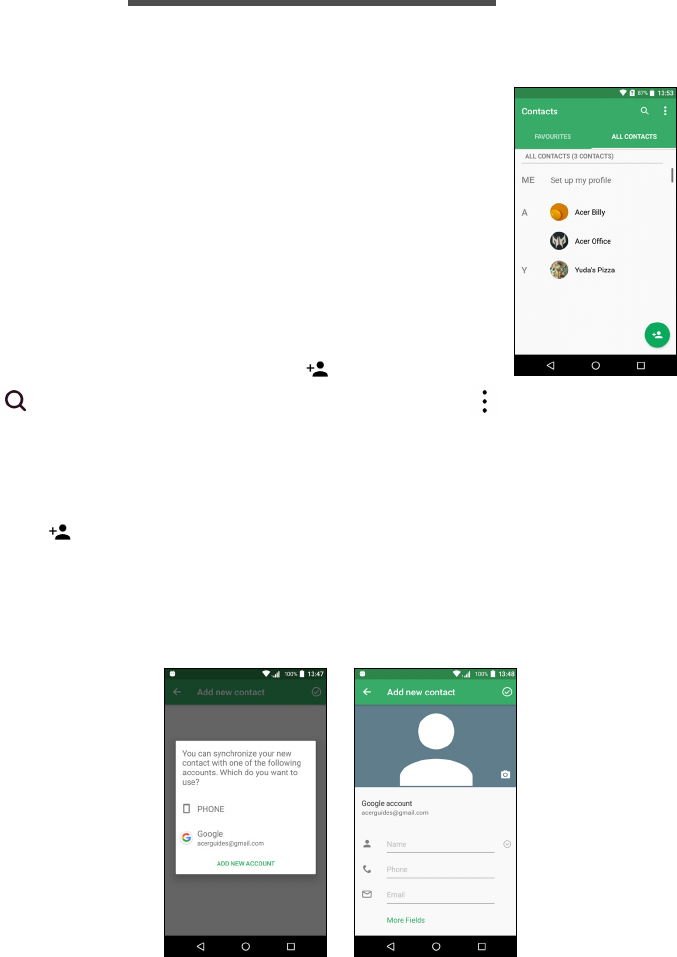
20 - Managing contacts
MANAGING CONTACTS
Managing your contacts
Your phone features an address book that allows
you to save contacts to either the internal memory
or onto your SIM card.
Tap the Contacts app from the Apps list or tap the
All contacts icon from the Dialer to view your
contacts.
If you don’t have any contacts stored on your
phone, you can import your Google account
contacts, add a new contact or import contacts
from your SIM or SD card. Open the People app
from the Apps list and then tap to add a contact,
to search for a contact, or tap the Menu icon
to open the menu.
Adding a contact
Tap to add a new contact. You may also scan a person’s profile
barcode to add the person to your contact list or group.
To create a contact, first choose where you want to store the contact’s
information. You will then be asked to enter the contact’s information,
such as name, phone number, and email.

Managing contacts - 21
You may scroll down the page and tap More fields to add things such
as:
• IM addresses.
• Add any personal notes about the contact.
• Phonetic name
• Link a website
To assign an image to your contact, tap the silhouette and select
whether to take a photo or select an image from your phone’s picture
gallery.
When done, click the Done icon at the top of the screen.
Tapping on the contacts name will bring up their profile. Tap while
viewing a contact’s profile to delete, share, or create a shortcut on the
Home screen for the contact. Tap to edit the contact’s details; tap
again for more options, where you may set a ringtone for the
contact, send all incoming calls to voicemail, or add a contact picture.
You may also create a contact from an already dialed or received
number, see Saving a dialed number to contacts on page 26.
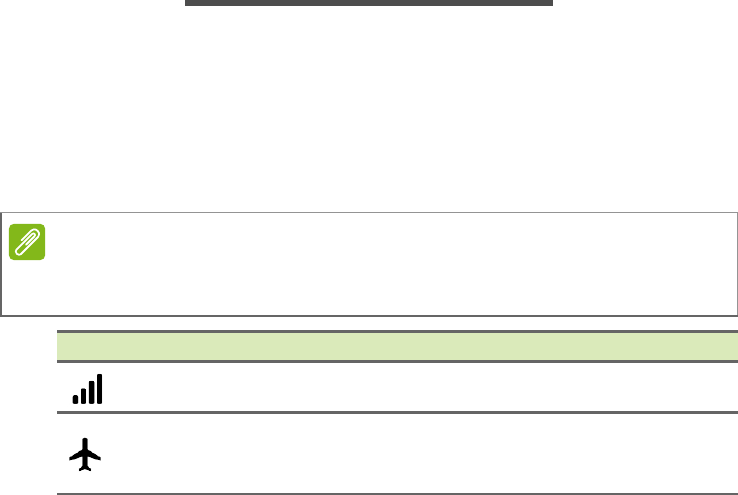
22 - Making calls
MAKING CALLS
This chapter shows you how to make phone calls, and the various
options available to you during your call.
Before making a call
Check that the phone function is on before you make a call. You can
confirm the phone status from the Notification area.
Note
Status and notification icon colors may vary. You will see an indicator icon for
each SIM card inserted.
Icon Description
Connected to the network: You may make a call.
Airplane mode: Wireless connectivity disconnected (Wi-Fi,
Bluetooth, and cellular). Please disable airplane mode
before trying to make a call.
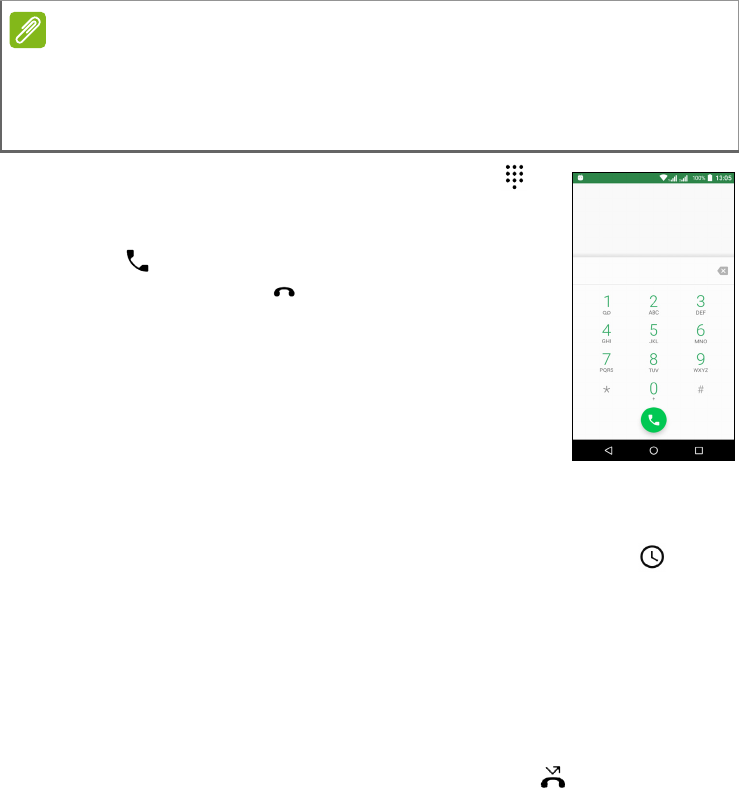
Making calls - 23
Making a call
1. From the Home screen tap Phone then to
open the onscreen number pad.
2. Enter the number you wish to dial.
3. Tap to make the call.
4. To end the call, tap .
If the contact you need is displayed, simply tap the
contact name to make a call.
Dialing a number from Call History
Your call history can be viewed by tapping the Call History icon. It
displays recent received, dialed, and missed calls.
Tap the phone icon to redial. To view call details and other options,
tap the number or contact’s name.
Viewing missed calls
Missed call notifications are displayed in the following three areas:
1. The Notification area with the missed call icon. Open the
Notification area and tap the missed call notification to display the
missed call details.
2. By the Phone icon (the number in the box is the number of missed
calls). Tap Phone from either the Home screen or the Apps list to
directly display the missed call details.
Note
If you have multiple SIMs inserted in the phone, you may be asked which SIM
to use before the call is connected. Depending on your SIM settings.
To select a SIM, just tap the name of the carrier.
See SIM Management on page 51.
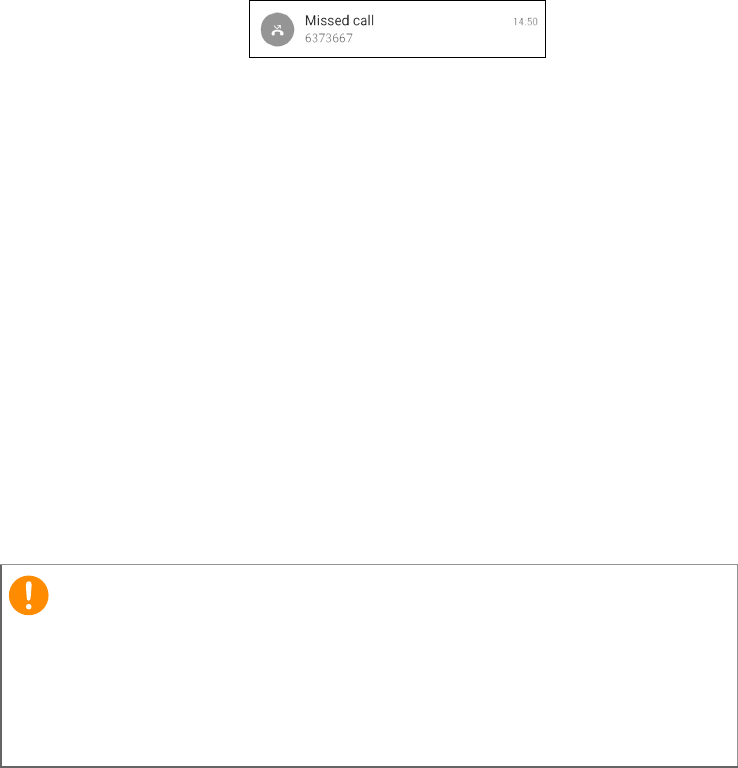
24 - Making calls
3. On your phone’s lock screen. Double-tap the notification to display
the missed call details.
Making a call to one of your contacts
Calling a contact from the Contacts tab
1. Tap the All contacts to view your contacts.
2. Tap on a contact to call them.
Calling a contact from the Contacts app
1. Tap the People icon the Apps list to view your contacts.
2. Tap on a contact to open their profile.
3. Tap on the contact’s phone number to call them.
Dialing an international number
When dialing international numbers, there is no need to enter the
international direct dialing prefix (’00’ etc.) before the country code.
Simply tap and hold 0+ on the onscreen number pad until + appears
onscreen.
Direct dial widget
You may add a direct dial widget for a contact on your Home screen.
Open the Apps list, then tap the Widgets tab. Tap and hold Direct
dial and you will be able to place the widget on your Home screen.
Once placed, you will be able to select a contact to associate with that
particular widget on your Home screen.
Important
International call rates can vary greatly depending on the country you
are calling and your network provider. We suggest you check all call
rates with your network provider, to avoid excessive phone bills. If you
are using your phone abroad, roaming charges will apply. Consult your
network provider for roaming rates specific to the country you are
visiting before you leave.
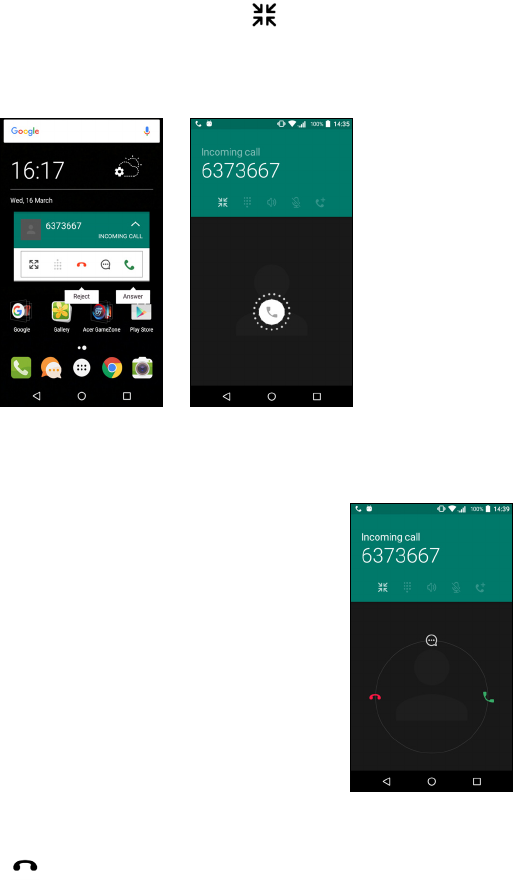
Making calls - 25
The voice call screen
You can minimize the call window to appear as a movable dialog
instead of a whole screen by tapping the icon. You can even set
this "floating" dialog box as the default voice call screen. To do so,
open Quick Settings (see Notification and status area on page 18).
Tap the Float caller icon to activate.
Answering or declining a call
When you have an incoming call, the number will
be shown on the screen. To accept or decline the
call, tap and hold the phone icon in the middle of
the screen, then slide your finger across the screen
towards one of the three icons that appear.
Ending a call
To end a call, tap from the voice call screen.
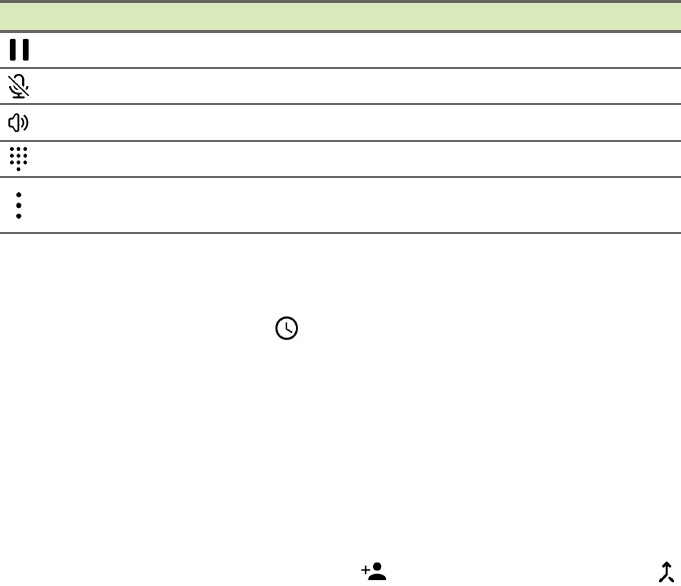
26 - Making calls
Voice call options
Icon Description
Place the call on hold.
Mute a call.
Speakerphone.
Access the keypad while a call is in progress.
One option:
• Add a second call
Saving a dialed number to contacts
You can save a number you have dialed to your contacts for future
use. From the Call History , tap the number and then tap Create
new contact and enter the information. See Adding a contact on
page 20. Alternatively you can tap Add to a contact to update an
existing contact’s information.
Conference calls
If you have one call on hold and another on line, you can combine
both calls to create a conference call.
After the first call is established, tap to add a second call. Tap
to start the conference call.
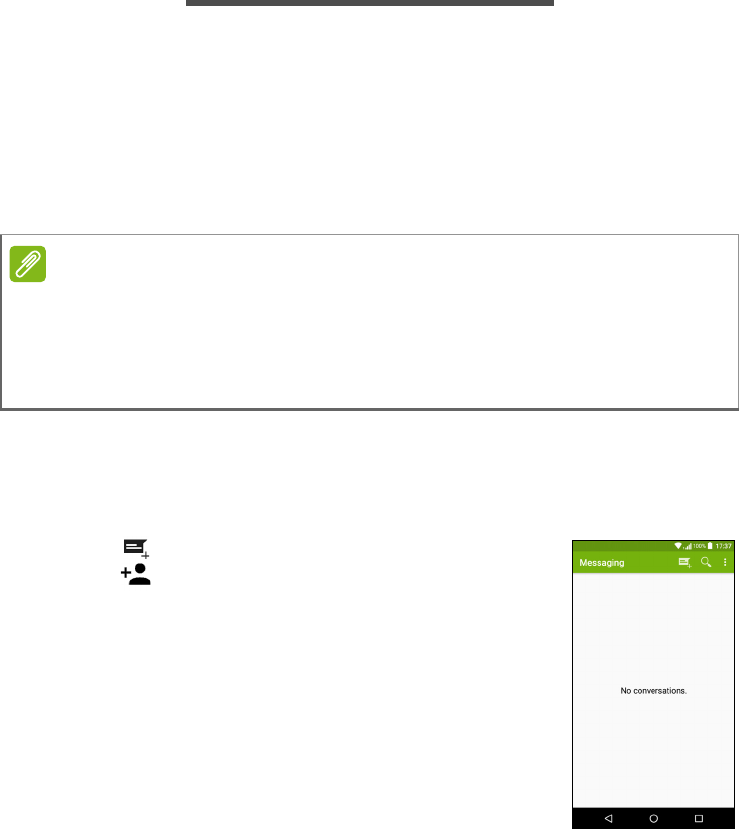
Text and multimedia messages - 27
TEXT AND MULTIMEDIA MESSAGES
This chapter shows you how to set up and use the Messenging app
on your phone to send text (SMS) messages.
All SMS and MMS messages are accessed via Messenging.
Messenging automatically arranges received and sent messages into
threads.
To access Messenging, open the Apps list or tap Messenging on the
Home screen.
Creating a new message
You can use your phone to compose text (SMS) and multimedia
(MMS) messages.
1. Tap to compose a new message.
2. Tap to add contacts from your contacts list, or
tap the Type name or number field to enter the
recipient’s phone number or name directly.
Suggested contacts will be displayed in a drop-
down list below the text field. To select a
suggested contact, tap the contact’s name.
Note
If you have multiple SIMs inserted in the phone, you will need to decide which
SIM to use before sending the message. You will be able to see which SIM
is the current SIM from the compose text box. To change SIM, tap and hold
the send icon.
See SIM Management on page 51 for more information.
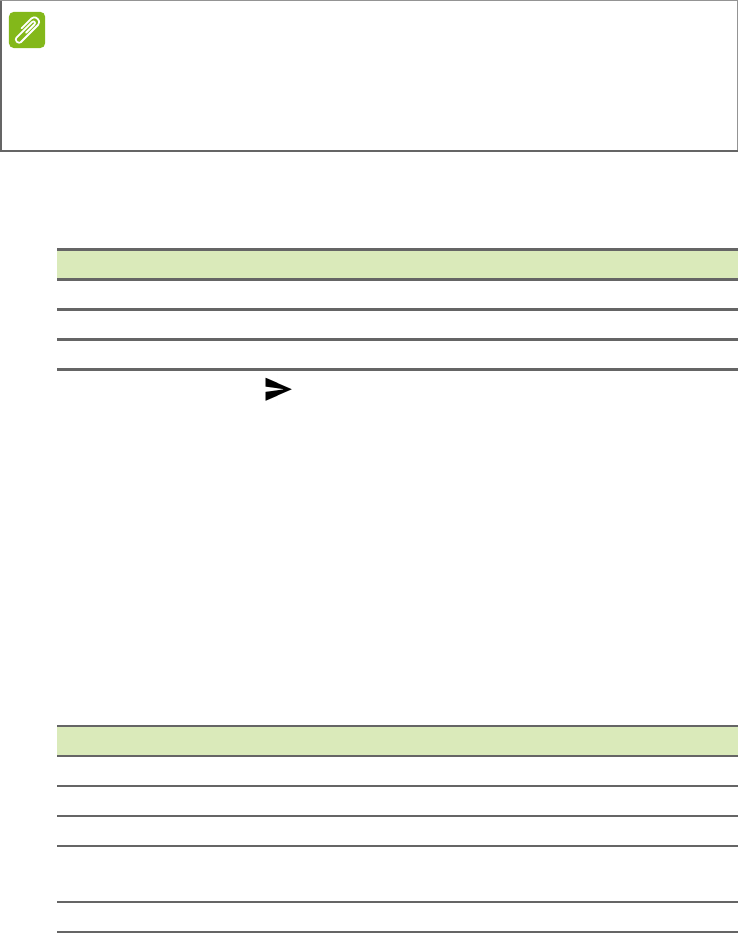
28 - Text and multimedia messages
3. Enter your message in the text box labeled Type text message.
Tap the menu button to see what options are available when creating
a new message. The options change depending on the status of the
message.
4. Tap the Send icon to send the message.
Replying to a message
When a new text message arrives a message icon appears in the
Notification area and the message icon at the bottom of the phone
displays the number of unread text messages.
Tap Messaging from the Apps list to view the message list or open
the Notification area to see a summary of the message. Tap the
summary to open the message list.
To reply to an SMS or MMS message, open the message from the
message list. Enter your text in the text box labeled Type message.
Tap the Menu button to see more options.
Note
Text messages may be up to 160 characters long. If your message is longer
than 160 characters, it will be sent as multiple linked messages. Most phones
will automatically join the linked messages to present the recipient with a
single long message, however, some older phones do not have this ability.
Option Description
Add subject Add a subject to the message.
Discard Discard the message.
Settings Additional settings for messages.
Option Description
Add subject Add a subject to the message.
Send Send a reply to the message.
Delete thread Delete the message.
Add to
Contacts Add the sender to your contacts list.
Chat settings Additional settings for messages.
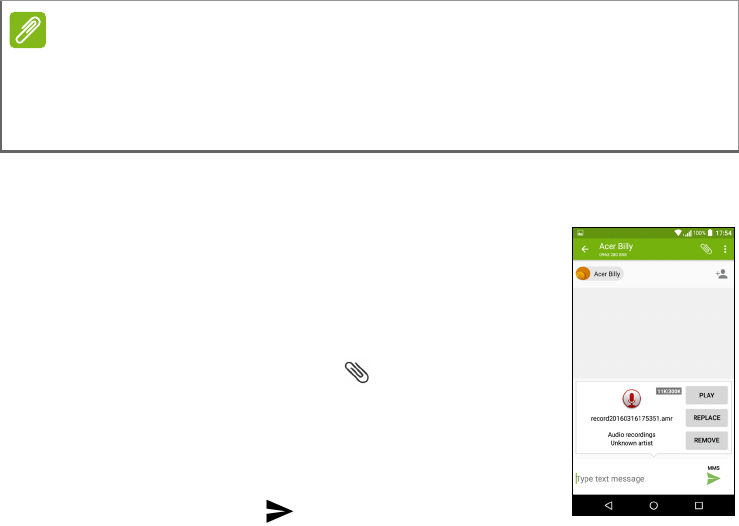
Text and multimedia messages - 29
Multimedia messages
Multimedia messages are similar to text messages but also allow you
to attach files such as pictures, audio or video clips. Each message
can be up to 300 kB in size.
Sending a multimedia message
Follow the instructions in Creating a new
message on page 27 to start a new message or
reply to an existing SMS as described in Replying
to a message on page 28.
1. To convert an SMS to a multimedia message, tap
the Add attachment icon at the top of the
screen.
2. This opens a list of attachment options. Select
one to either find a file on your phone or create a
new attachment.
3. Tap the Send icon to send the message.
Receiving multimedia messages
When a new multimedia message arrives, a message icon appears at
the top of the screen and a notification message is displayed.
1. The notification message displays a summary of the message. Tap
View to view a summary of the message.
2. Tap Download to download the message content. Downloads can
take a long time, depending on your connection quality. If you reply
or open another app, the download will be stopped.
Note
You need to set up an MMS profile before you can send MMS messages.
Normally, your phone will set up the profile automatically.
Ask your network provider for the necessary information if you need to
manually set up the MMS profile.
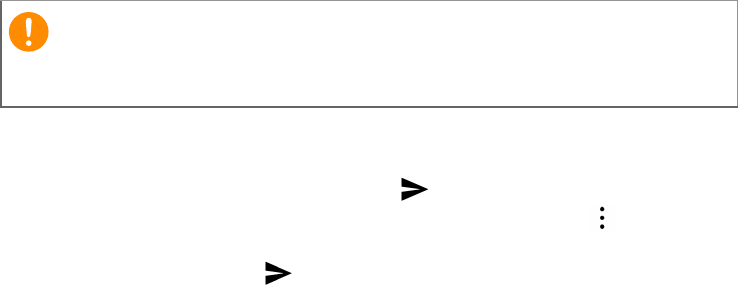
30 - Text and multimedia messages
3. Tap the message to view the content.
4. To reply to the message, enter your text in the text box labeled Type
message and tap the Send icon . Simple text replies will be sent
as SMS messages. If you wish to attach a file, tap . You will be
presented with a menu of options.
5. Tap the Send icon to send the message.
Important
You may be charged to download message content, especially if you
are roaming. Please contact your provider if you have any questions.
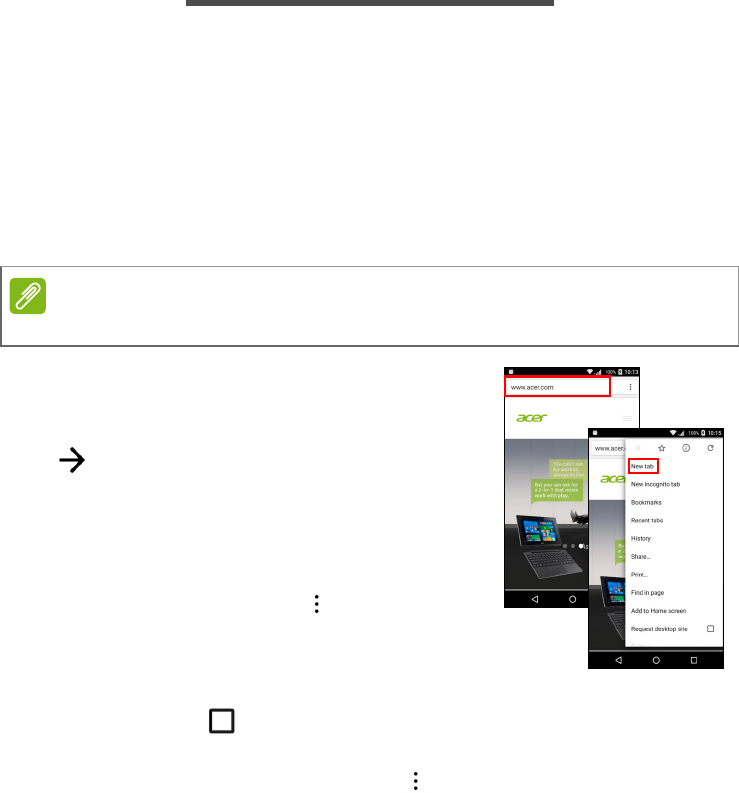
Going online - 31
GOING ONLINE
Browsing the internet
In order to browse the internet with your phone, you must be
connected to a data or wireless network.
Using the browser
To start browsing, tap the Chrome icon in the Favorites tray or the
Apps list.
To open a new website, tap the address
box at the top of the page. Enter the
address using the keyboard and tap Go
. You can zoom in or out of pages by
pinching or reverse pinching.
To navigate forward and backward in your
browser’s history, view your bookmarks,
adjust browser settings, and perform other
tasks, tap the Menu icon .
Chrome enables you to open multiple
pages. By default, tabs are visible in the
phone’s Overview screen. Tap the
Overview icon at the bottom of the screen to display all of your
open tabs (tap again to close). Tap a tab from the list to open it. To
open a new tab, tap the Menu icon > New tab.
Setting up email
Your phone enables you to access your email through the Gmail app.
If you sign in for the first time using a Gmail account, your information
will automatically be used to create your Inbox on your phone.
Note
Reference images use the Chrome browser.

32 - Going online
To add another account, open Settings from the Apps list, then tap
Accounts > Add account > [account type].
Enter the email address for the new account. If you have selected the
wrong account type, you will be asked to confirm which account type
to use.
Enter the password for the account and, if necessary, grant the Gmail
app permission to access your account.
Most popular ISPs can be set up in just a few steps. If you are unable
to set up the account automatically, enter your email address and tap
Manual setup to enter the parameters manually. Tap Next to finish
the setup process.
Google services
You must activate a Google account before using Google services.
The first time you access Google services, you must read and accept
the Terms of Service.
Setting up your Google email
1. Make sure your phone is connected to a data or Wi-Fi connection.
2. From the Apps list tap Gmail.
If you did not enter your Gmail account address and password when
you first started your phone, follow the onscreen instructions.
Composing an email
1. Make sure your phone is connected to a data or Wi-Fi connection.
2. From the Apps list tap Gmail.
3. Tap .
4. Enter the recipient's email address, the subject and message.
5. When you are finished composing your message, tap .
Note
Apps may not be available in all countries and regions.
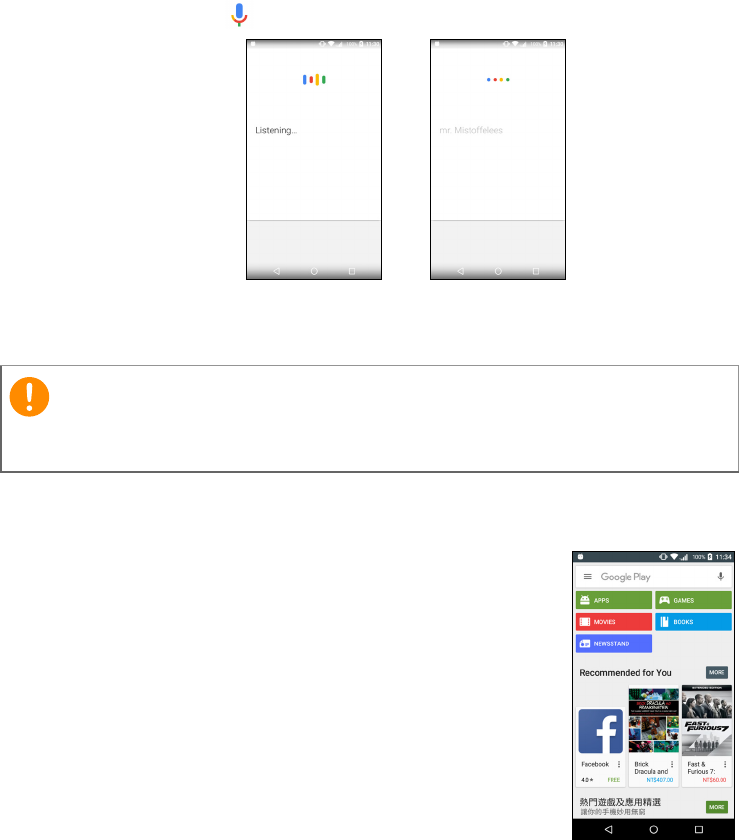
Going online - 33
Voice search
With voice actions, you can send text messages, place calls, send
emails, find directions of establishments, automatically call
establishments, search the internet and even send a note to yourself
using your voice. Tap Voice Search from the Apps list, or tap the
microphone icon on the Home screen.
Play Store
Tap Play Store from the Apps list to open the Google Play app. Here
you can obtain a variety of apps to enhance your phone.
The contents and design of Google Play varies by
region. For example, in some regions, you can also
browse for and purchase movies, books,
magazines, or music. Updates may add new
categories or change how to navigate Google Play
at any time.
You can browse the store by category or tap the
search icon to search for a specific app.
Once you have selected an app, tap Install to
download and install the app. You will be told which
services the app requires access in order to
function correctly (e.g. contact information, wireless
Important
For connection issues with Play Store, see FAQ and troubleshooting
on page 53.
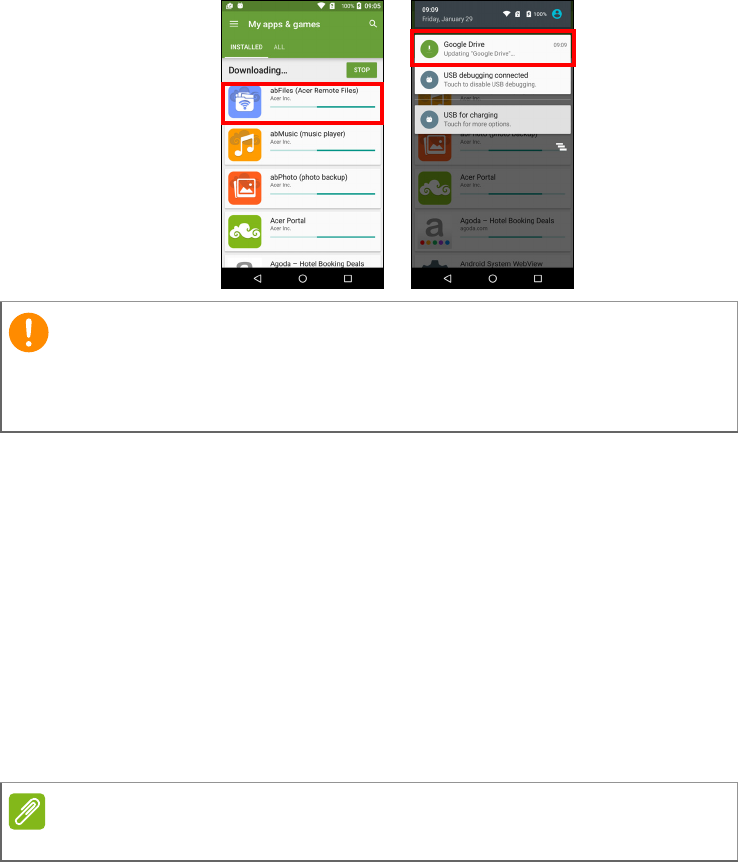
34 - Going online
access, GPS). If none of these services seem unusual, tap Accept &
download to proceed with the installation.
You may keep track of the download progress from both the app’s
page and the notification area.
Using downloaded apps
Once you’ve downloaded and installed an app, you may find it in the
Apps list or Widgets list.
Certain apps provide both an App and widget, or only provide a widget
(with no app icon). See Personalizing the Home screen on
page 14.
Uninstalling downloaded apps
Once you’ve downloaded and installed an app, you may uninstall the
app by opening the Apps list and tapping Settings > Apps. Scroll
through the list of apps and select the the app you wish to uninstall.
Tap UNINSTALL.
Important
Some apps may require payment before you can download them. You
will need to have a Google Wallet account in order to pay for these
apps, or a credit card number associated with your Google account.
Note
Deleting an app icon from the Home screen only deletes the shortcut.

Going online - 35
Google Hangouts
Tap Hangouts from the Apps list to open Google Hangouts. Here you
can see a list of your contacts connected to Google Hangouts
services. Tap on a contact to open a chat session. After you have
connected, you can open a video chat session.
Maps, Navigation, Places and Latitude
Get easy-to-follow directions using Google Maps, view real-time traffic
condition and navigate by using spoken, turn-by-turn driving
instructions. Also, view where your friends are, places of interest, and
local businesses.
Using the map
Tap the Maps icon in the Apps list. Drag the map with your finger to
move the map around.
To zoom in or out:
1. Double-tap a location on the map to zoom in on the location, and tap
once to zoom out, or
2. Touch an area with two fingers at once and spread them apart to
zoom in, and pinch them together to zoom out.
Note
Maps does not have information about every location.
Some locations may not have all zoom levels.
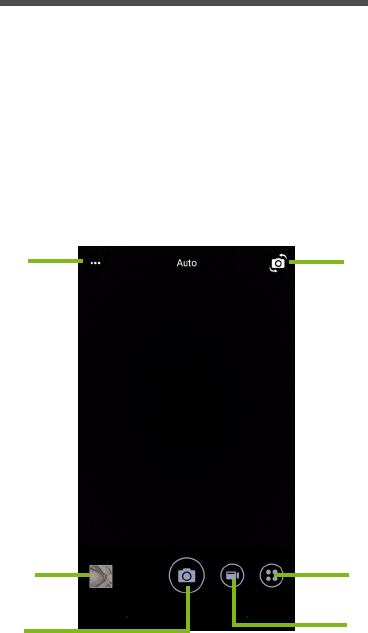
36 - Using the Camera
USING THE CAMERA
Your phone features two digital cameras mounted on the front and on
the rear. This section will take you through all the steps in taking
photos and videos with your phone.
To activate the camera, open Camera from the Apps list or the
Favorites tray.
Camera/camcorder icons and indicators
Camcorder button
Switch camera
Last picture / Mode selector
Shutter
Settings
video taken
button
The camera window provides multiple controls on the image screen.
Tap the area of the image you want to be the point of focus for the
auto-focus lens (only available on the rear camera). Zoom in or zoom
out using a two-finger pinch gesture.
Tap the Shutter button or press the volume button to take a picture.
Tap the thumbnail in the bottom-right corner to open the gallery.
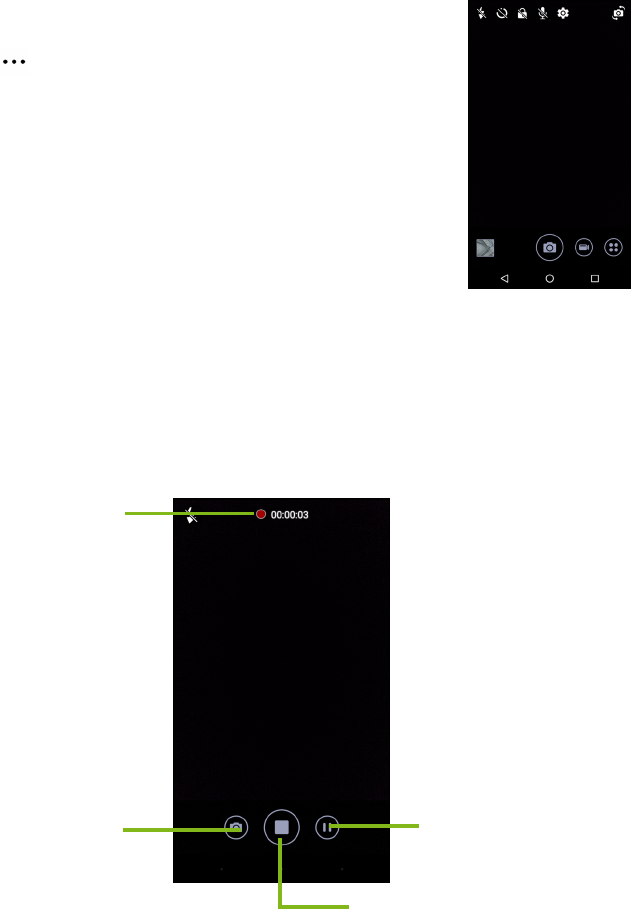
Using the Camera - 37
Your camera has a number of settings that you can
adjust. Access the settings by tapping the Menu
icon in the upper left-hand corner.
From left to right:
•Flash: Tap to cycle through Off, On, Auto.
•Timer: Tap to cycle through 3, 5, or 10 second
delay.
•Private album: Tap to set up and save images to
a password-protected private album.
•Microphone: Tap to turn the microphone On or
Off.
•Settings: Tap to adjust settings for the camera, camcorder, or global
settings.
Tap the Camcorder button and the camcorder immediately begins
filming. While filming, you are unable to access camera/camcorder
settings; however, you can still take pictures.
Tap the Pause button to temporarily stop recording and tap it again to
restart recording. Tap the Stop recording button to stop filming.
Time elapsed
Pause recording
Shutter button
Stop recording
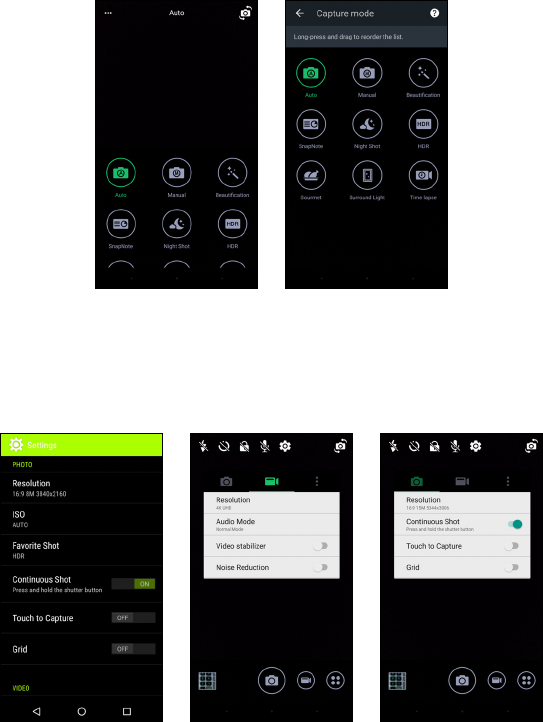
38 - Using the Camera
Mode selector
Tap the Mode selector icon to open the list of modes you can choose
from. Swipe the mode selection pane upwards to see more options.
Tap a tile to select a mode (available modes may vary depending on
your camera version and software updates).
Settings
Tap the Settings icon to open the settings menu; scroll up or down the
list to view more settings
Camera
You may adjust the following:
•Resolution: Set the picture resolution.

Using the Camera - 39
• Turn Continuous Shot On or Off. This allows you to take multiple
shots by tapping and holding the shutter button down.
• Turn Touch to Capture on or off: If enabled, the camera will focus
on the spot where you tap and automatically take the photo.
• Turn the framing Grid On or Off.
Camcorder
You may adjust the following:
• Set the Resolution.
• Turn the microphone On or Off in Audio Mode.
• Turn Video stabilizer on or off.
• Turn Noise Reduction On or Off.
Other
You may adjust the following:
•Storage: Choose between Internal storage and SD card.
• Turn GPS Location info on or off: Stores GPS information in the
image information.
• Launch transition: Show an animation when the camera app starts
showing options that can be activated by swiping left or right.
•Tutorial: View brief introductions to each of the capture modes
available.
•Reset to default.
Favorite Shot settings
Swipe in from the left to open Favorite Shot settings. Set White
balance, ISO values, EV, Metering, Contrast, Saturation and
Sharpness. These values will be stored for quick access.
Swipe left to return to use Auto picture settings.
Note
Some of the following settings are not available for the front camera.

40 - Using the Camera
Selfie mode
Swipe in from the right to open the Selfie camera. Use Pause N Shoot
mode to automatically take a picture if a face is detected in the frame.
Swipe right to return to use Auto picture settings.
Taking a photo
1. Ensure you have adjusted the settings described above.
2. Frame your subject and steady your phone.
3. Zoom in or out as needed.
4. Tap the Shutter button to take a picture.
Shooting a video
1. Frame your subject and steady your phone and zoom in or out as
needed.
2. Tap the Camcorder button to start taking a video. The icon will turn
red to indicate that recording is in progress. Tap the icon again to
stop recording.
Supported formats
Viewing photos and videos
After you have taken your photo or video, it is automatically saved.
Once you have taken a photo or video, you can view it in Gallery by
tapping the thumbnail in the corner of the image screen. Alternatively,
open the Apps list and tap Gallery. From Gallery you can share the
file directly using various services. Services vary depending on the file
type.
You may also edit individual photos you have taken by tapping the
pencil icon in the lower left-hand corner of the screen.
Note
To see supported image, video, and audio formats, see Connectivity on
page 61.
Using the Camera - 41
Geotagging
Geotagging allows you to store the location where a photo or video
was taken right in the photo or video itself.
For the geotag to display, pictures must be taken with GPS location
info turned on.
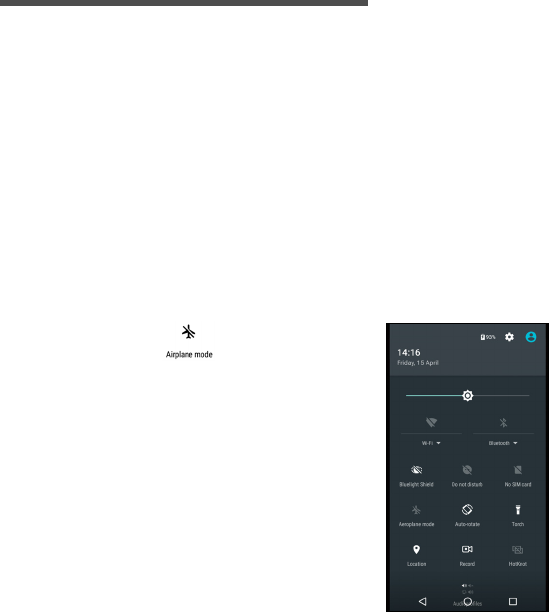
42 - Advanced settings
ADVANCED SETTINGS
Putting your phone in Airplane mode
You can enable Airplane mode (also known as flight mode) to turn off
cellular, Wi-Fi and Bluetooth functions and use your phone as a
handheld device during a flight. Check with your airline to make sure
this is permitted onboard.
Switch your phone off during takeoff and landing as it may interfere
with aircraft electronic systems.
Turning Airplane mode on or off
Open Quick Settings and tap .
Restarting your phone
You can restart (’reboot’) your phone if you find apps are not
responding.
1. Press and hold the power button until you get the phone options
menu.
2. Tap Restart.
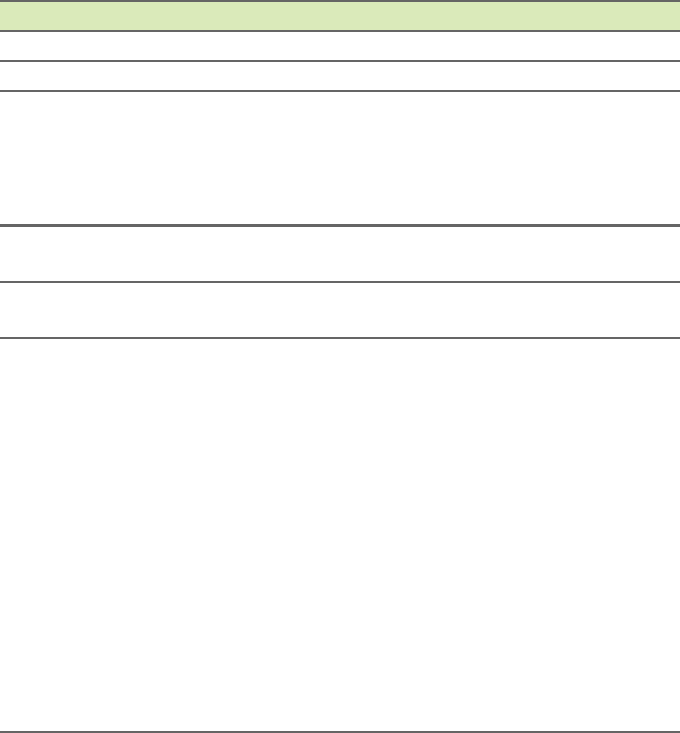
Advanced settings - 43
Adjusting settings
Wireless & networks (managing connections)
Open the Apps list and tap Settings to manage your connection
settings.
If your phone is in Airplane mode, the option to turn Bluetooth on will
be disabled. Please refer to Putting your phone in Airplane mode
on page 42 for instructions on turning Airplane mode on or off.
Item Description
Wi-Fi Turn the Wi-Fi function on or off.
Bluetooth Turn the Bluetooth function on or off.
SIM cards
Set a default SIM for particular functions
(such as voice calling or messaging), turn the
data connection on or off, set roaming
preferences and associate contacts with a
SIM.
Data usage View an estimate of the mobile data used for
each SIM.
Call Settings Change various settings related to making
and receiving calls.
More...
Access additional connection settings:
Airplane mode: Disable all wireless
connections so you can safely use this device
onboard an aircraft.
SMS app: Set the app used to send and
receive SMS.
Tethering & portable hotspot: Share your
phone’s mobile data connection via USB or as
a portable Wi-Fi hotspot.
VPN: Set up and manage Virtual Private
Networks.
Cellular/Mobile networks: Set your options
for connecting to cellular networks.
Cell broadcasts: View active alerts for your
area.

44 - Advanced settings
Adjusting Bluetooth settings
You can use Bluetooth to exchange information between your phone
and other mobile devices.
Bluetooth connections
For all Bluetooth settings, open the Apps list and tap Settings >
Bluetooth. Tap the toggle switch next to turn Bluetooth on or off.
When you turn Bluetooth on, your phone will automatically search for
any nearby devices that are discoverable. Your phone will be
discoverable as long as you have the Bluetooth settings open.
To connect to a device, tap the device in the list of available devices.
You may be asked to enter a PIN on both devices to establish the
connection.
To simply turn on or off Bluetooth, open the Notification area and tap
the Bluetooth icon.
Internet sharing
Tethering via USB
If you wish to share your mobile internet connection with a computer,
you can connect your phone to a PC using the supplied USB cable.
1. Plug the USB sync cable into the USB connector on your phone.
2. Plug the USB client connector into an available USB port on your
computer.
3. Open Settings > More.. > Tethering & portable hotspot > USB
tethering to turn USB internet sharing on or off.

Advanced settings - 45
Wi-Fi hotspot
You can turn your phone into a portable Wi-Fi hotspot to share your
mobile internet connection with up to eight clients.
1. Open Settings > More... > Tethering & portable hotspot >
Portable Wi-Fi hotspot.
2. Tap Set up Wi-Fi hotspot, and change the Network name, security,
and password as necessary. Tap SAVE to finish.
Phone network settings
In the Apps list tap Settings > More... > Cellular networks to adjust
your network settings. You can turn data connection on or off when
roaming, choose a preferred network type, specify a network operator
and define access point names.
Selecting a network
Your phone will automatically detect your carrier/network settings
when you insert a new SIM card. However, you may prefer to
manually select a network when roaming.
1. Open the Apps list and tap Settings > More... > Cellular networks
> Network operators > Search networks.
2. Your phone will search for available networks.
3. Select your preferred network from the list generated. You phone
will attempt to register on the selected network.
Note
When your phone is serving as a Wi-Fi hotspot, you can only access the
internet via your phone’s data connection, and you may incur data charges.
Note
When you are traveling, manually selecting a network may help to reduce
your roaming charges. Check with your home service provider for the
network offering the most competitive rates at your destination.

46 - Advanced settings
4. Tap Select automatically to connect to the available network with
the strongest signal. This may lead to your phone jumping between
networks when you move around.
Data usage control settings
Data usage controls let you monitor total usage by network type and
app and then set limits if needed.
Ensure Wi-Fi or mobile data is enabled before setting a limit. Access
data usage settings from the Apps list by tapping Settings > Data
usage. Tap Set cellular data limit to set a threshold at which your
data connection will automatically be disabled.
Phone settings
Many phone settings are automatically configured by your phone
when you insert a SIM card. The device will communicate with your
provider and automatically obtain all necessary settings, such as
network name, voice mail and text message center numbers.
You can also view and modify these settings manually through the
Call settings screen.
Open Settings > Call settings.
Adjusting the volume
Adjust the volume of your phone using the volume button on the side
of the phone. Alternatively, you can set the Ringtone, Notifications,
and Alarms volume by opening Settings > Sound & notification and
then adjusting the sliders under Sound.
Note
Contact your service provider should you have any problems obtaining voice
mail and the text message service center numbers.
Important
Your phone and your cellular carrier may calculate data usage using
different criteria. Your carrier will charge you according to their
methods: Please consider setting a conservative limit.

Advanced settings - 47
Display
To adjust your phone’s display settings, in the Apps list tap Settings >
Display.
You can also adjust the screen brightness, turn casting or screen
rotation on or off from Quick Settings.
Setting the date and time
To set the date and time, open Settings > Date & time.
If you travel frequently or live in an area that uses daylight saving
time, tap Automatic date & time and Automatic time zone to turn
them both on. This will enable your phone to set the date and time
based on information it receives from the network.
Setting alarms
There are two predefined alarms on your phone by default. Open
Clock from the Apps list, and then tap to view the alarms. Tap and
hold an alarm to change its settings. You may:
• Turn the alarm on or off.
• Set the alarm time.
• Set which days to repeat the alarm.
• Set a ringtone.
• Enable or disable vibrate.
• Give it a label.
Changing language and text options
Set your location and language input preferences by opening
Settings > Language & input.
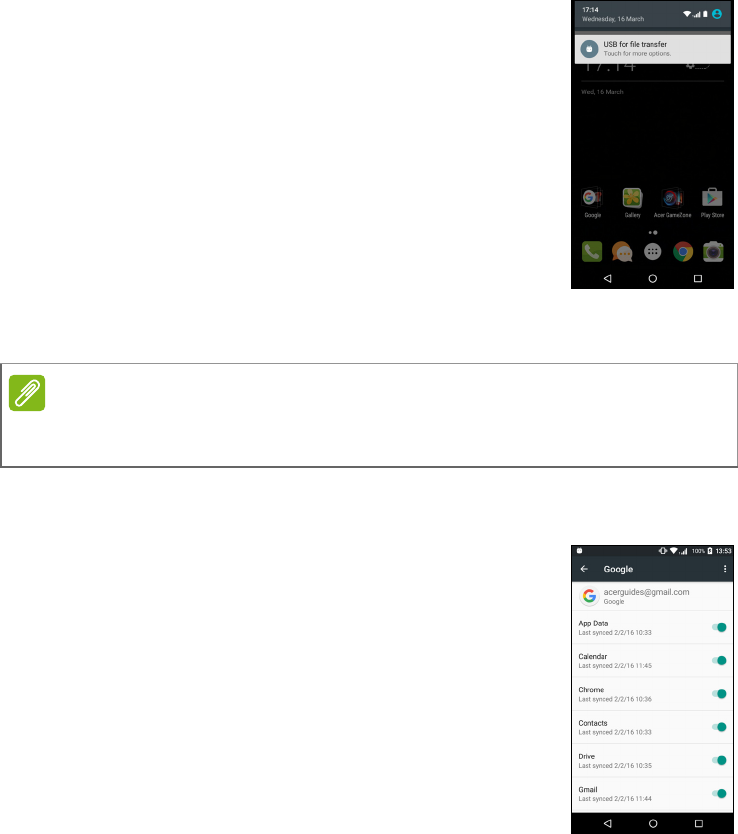
48 - Advanced settings
Connecting to a PC
If you wish to transfer information between your
device and your computer (either the microSD card
in your device or the device’s internal memory),
you can connect your device to a PC using the
supplied USB cable.
1. Plug the USB sync cable into the USB connector
on your phone.
2. Plug the USB client connector into an available
USB port on your computer.
3. Open the notification area and tap USB for
charging then choose File transfers.
Your device will now be available as a drive in your computer’s file
explorer.
Synchronization
You can sync your calendar, email and contacts on
your phone and never worry about losing them
again. Sync in real time or adjust it as you please.
Open Settings > Accounts > [account name] to
access the synchronization settings.
To add a new account, tap Add account. Select
the type of account and then follow the onscreen
instructions.
Google Sync
In Google, you can set synchronization for Google services. In your
Google account’s synchronization settings menu, tap the item you
would like to have auto-sync. Tap again for manual synchronization.
Note
After turning on USB storage, you will not be able to access the files in the
microSD card or apps such as Gallery or Music.
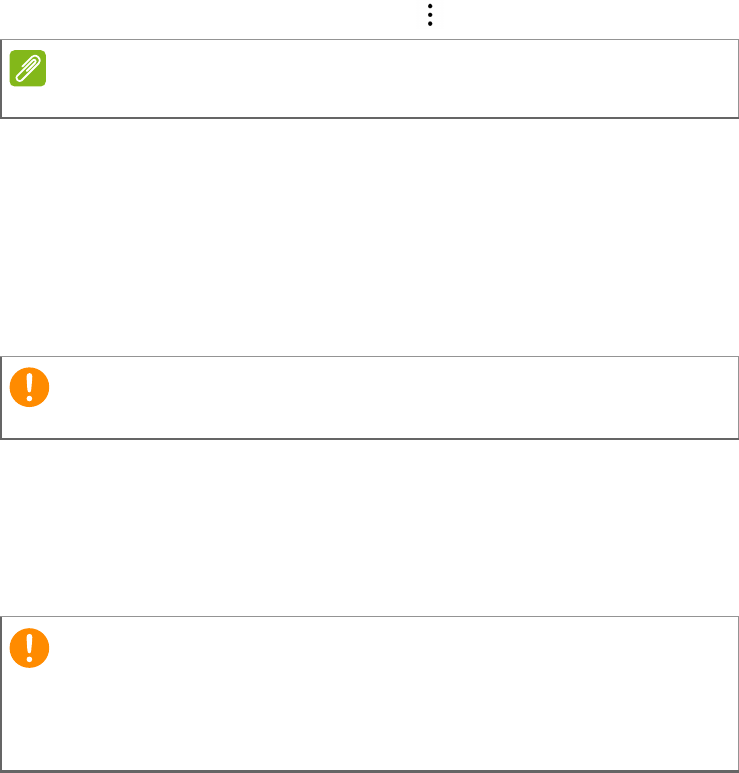
Advanced settings - 49
To manually synchronize an item, make sure toggle switch next to the
item is turned on, tap the Menu icon and then tap Sync now.
Apps (applications)
Uninstalling an app
You can remove programs installed on your phone to free up extra
storage memory. From the Apps list, tap and hold the app you wish to
uninstall, and then drag it to "Uninstall" at the top of the screen. You
will be asked to confirm the uninstall; tap OK.
Restoring to factory settings
You may perform a clean boot to restore your phone to the factory
settings. Before performing a clean boot, ensure that your phone is
not locked. Press any button or tap the screen to see if the phone
responds.
If your phone is responding to screen input, then open Settings from
the Apps list. Tap Backup & reset > Factory data reset > Reset
phone and then Erase everything to format your phone.
Note
You need a Google account to sync your calendar and appointments.
Important
Can only uninstall apps that you have downloaded from Play Store.
Important
You should only perform a clean boot when all other options have failed
to restore your phone to an operational state.
This will erase all your personal information, any contacts stored on
your phone and any programs you installed.

50 - Accessories and tips
ACCESSORIES AND TIPS
This chapter shows you how to use accessories with your phone, as
well as provide useful tips for when you are using your phone.
Using the headset
Your phone is compatible with headsets with built-in microphone for
handsfree use when making calls.
To use the headset, plug it into the 3.5 mm headphone jack at the top
of the phone.
When the headset is plugged in, all audio is routed to the headset,
and the speakers are turned off.
• To answer an incoming call, press the button on the microphone.
• Adjust the volume using the volume up/down button on the phone.
• End the call by pressing the button again.
Using a Bluetooth headset
Your phone’s Bluetooth functions make it fully compatible with all
Bluetooth headsets. This allows you to use the unit handsfree when
making calls, without the inconvenience of wires.
Creating a new access point
When you need to add another cellular connection on your phone,
obtain the access point name and settings (including username and
password if required) from your wireless service provider.
1. Open the Apps list and tap Settings > More... > Cellular networks
> Access Point Names, and select an operator.
2. Tap the Add icon and then enter the APN settings. Tap an item to
adjust it.
3. When you have finished tap the Menu icon and then tap Save.
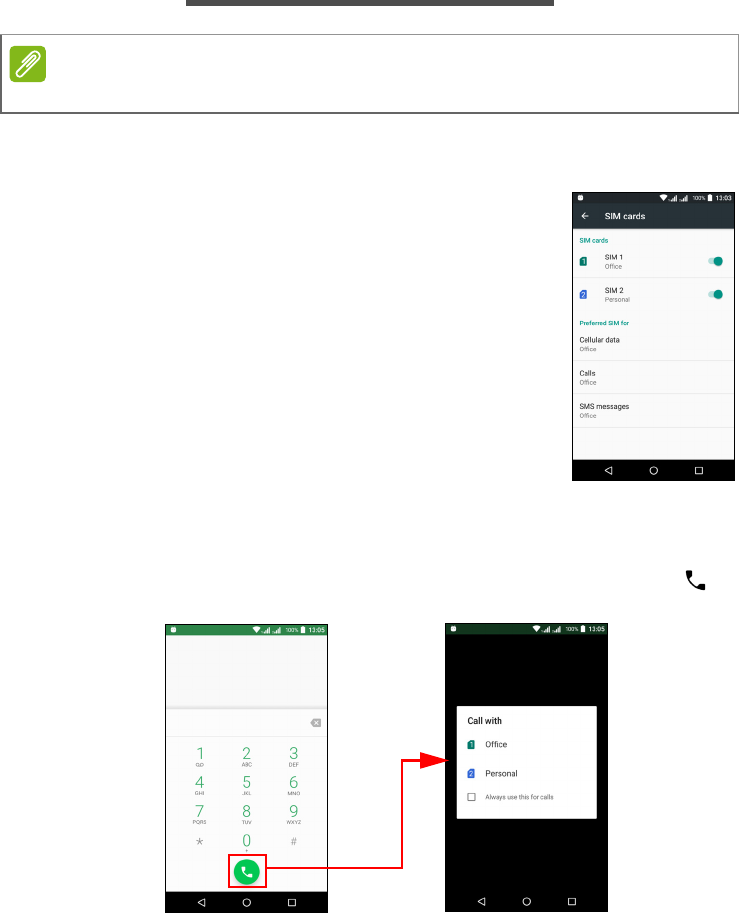
Managing your SIM cards - 51
MANAGING YOUR SIM CARDS
SIM Management
Open the Apps list and tap Settings > SIM cards.
From this screen, you can:
1. Enable or disable each SIM.
2. Configure each SIM’s name, phone number,
display numbers, and assign a color to each SIM
(allowing you to quickly and easily recognize
which SIM is active).
3. Set the default SIM for voice calls, data
connection, and cellular service.
4. General settings for each SIM.
Selecting which SIM to use when making a call
If you have set Voice call to Always ask, you will be asked which SIM
to use each time you make call. Enter the number, then tap . A
dialog opens; tap the SIM to use and the call will be connected.
Note
This chapter is for models with more than one SIM card.
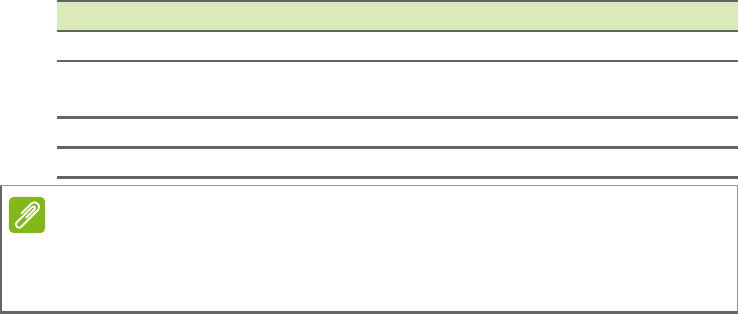
52 - Managing your SIM cards
Identifying calls
Whenever you receive a call, the caller’s number will be shown using
the color defined for the SIM that the call is being received on. You will
also be shown the name of the SIM receiving the call.
In the call log, the name of the SIM will be shown beneath the number
of the call -- whether the call was missed, answered or was an
outgoing call -- in the color you defined for that SIM.
Limitations when using multiple SIMs
When a SIM is: Other SIM cannot:
In a call Dial out
Ringing Receive a call (caller will get a
"number not available" message)
Sending or receiving a message Send or receive a message
Using a data connection Use a data connection
Note
If you are using data on one SIM and you make or receive a call, or send or
receive a text message on another SIM, the first SIM’s data connection will
be temporarily halted.

Appendix - 53
APPENDIX
FAQ and troubleshooting
This section lists frequently asked questions that may arise during the
use of your phone, and gives easy answers and solutions to these
questions.
Audio
Question Suggestions
Why is there no
sound coming from
the device?
If the headset is plugged into the device, the
speaker is automatically shut off. Disconnect
the headset.
Check that the device volume setting is not
muted.
Check that the volume control is not at its
lowest setting.
Multimedia files
Question Suggestions
Why can’t I view my
picture files?
You may be trying to view an
image that is not supported. See
Connectivity on page 61.
Why can’t I view my
video files?
You may be trying to view a video that is not
supported. See Connectivity on page 61.
Why can’t I play my
music files?
You may be trying to play a file that is not
supported. See Connectivity on page 61.

54 - Appendix
Google Play Store
Question Suggestions
Why can’t I connect to
the Play Store?
System information and performance
Question Suggestions
How do I check the
OS version of my
device?
Tap Settings > About phone to check the OS
version (Build number) and other hardware
and software information.
Power
Question Suggestions
I can’t turn on the
device.
The battery power may be depleted. Recharge
the device. See Charging the battery on
page 6 for more information.
RAM / ROM
Question Suggestions
How do I check the
RAM and ROM
memory status?
To check the ROM status, tap Settings >
Storage & USB.
1. First check that you have a Wi-Fi or data
connection (some Wi-Fi "hotspots" require
you to log in before accessing the internet)
and then try again.
2. If you still cannot connect, try adjusting your
date/time settings. Open Settings > Date &
time and turn Automatic date & time off.
3. Manually adjust the time and then try to
reconnect to the Play Store.

Appendix - 55
Internal storage
Question Suggestions
My device’s available
internal storage is full
or almost full.
Uninstall apps to increase available storage.
See Uninstalling an app on page 49.
Security
Question Suggestions
I forgot my unlock
pattern.
After a certain number of wrong entries, you
will be presented with an option to reset your
pattern. Tap Forgot pattern? and enter your
Google account username and password.
You must have an active Google account on
the phone.
Alternatively, you restore your phone to factory
settings. See Restoring to factory settings
on page 49.
Temperature
Question Suggestions
The phone heats up
when charging or
making long duration
calls.
It is normal for the phone to heat up when
charging. When charging is complete, it will
return to its normal temperature.
It is also normal for the phone to heat up
during long periods of use, such as watching a
video or a long phone conversation.
Other sources of help
For information on Refer to ...
Up-to-date information regarding
your phone
www.acer.com
mobile.acer.com
Service enquiries www.acer.com/support
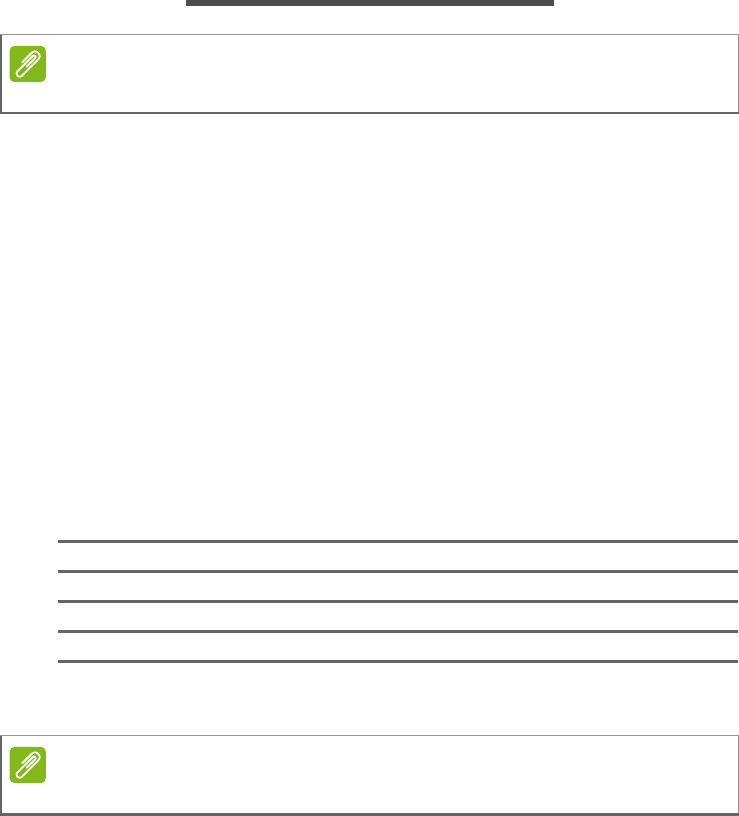
Specifications - 61
SPECIFICATIONS
Performance
• Quad-core processor (MT6735 1.3 GHz)
• System memory:
• 2 or 3 GB of RAM
• 16 or 32 GB of ROM
• Android operating system
Display
• 5.5" IPS LCD, capacitive touchscreen
• 720 x 1280 HD resolution
Dimensions
Connectivity
• Bluetooth 4.0 + LE
• IEEE 802.11b/g/n
•4G LTE
Note
Specifications may vary depending on region and configuration.
Height 154.3 mm
Width 77.4 mm
Thickness 9.75 mm
Weight <175 g (with battery)
Note
Frequencies and bands supported vary depending on model.
62 - Specifications
• 1900 (Band 2) / AWS (Band 4) / 850 (Band 5) /
2600 (Band 7) / 700 (Band 12) / 700 MHz (Band 17 / Band 28)
• HSPA+/WCDMA:
• 850 (Band 5) / 1900 (Band 2) / 1700 (Band 4) /
2100 (Band 1)
• GSM/GPRS/EDGE:
• 1900 MHz; 1800 MHz; 900 MHz; 850 MHz
• LTE FDD/TDD R9 Cat4 150/50 Mbps
• HSDPA up to 42 Mbps, HSUPA up to 11 Mbps
• GPRS Class 12 / EDGE Class 12
• GPS, with aGPS support and SUPL
Expansion
• microSD memory card slot (up to 32 GB; SDHC 2.0 compatible)
• Micro USB connector
Camera
• 13 MP rear camera
• Laser auto-focus with PDAF
• LED flash
• 5 MP front camera
• Fixed focus
Power
• Adapter
• AC input: 100 to 240 V, 50 or 60 Hz
• DC output: 15 W
• Micro USB connector
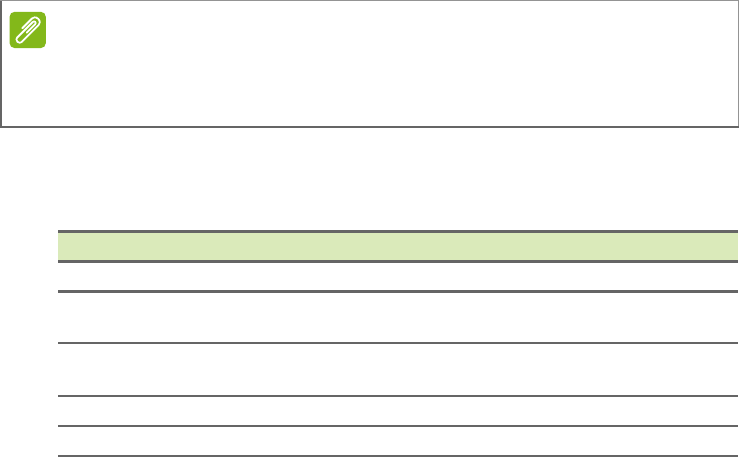
Specifications - 63
• 5000 mAh nominal-rated Lithium-ion battery (not user-replaceable)
Multimedia
Formats supported:
Note
Length of battery operation will depend on power consumption which is
based on system resource use. For example, constantly using the backlight
or using power-demanding apps will shorten battery life between charges.
Type Formats
Image JPEG, GIF, PNG, BMP
Audio playback MP3, AMR, AAC LC, AAC+, eAAC+, Vorbis, FLAC,
MIDI, WAVE
Ringtone MP3, AMR, AAC LC, AAC+, eAAC+, Vorbis, FLAC,
MIDI, WAVE
Video recording H.263, H.264, MPEG4
Video playback H.263, H.264, MPEG4, VP8

64 - End User License Agreement
END USER LICENSE AGREEMENT
IMPORTANT-READ CAREFULLY: THIS END USER LICENSE AGREEMENT ("AGREEMENT")
IS A LEGAL AGREEMENT BETWEEN YOU (EITHER AN INDIVIDUAL OR A SINGLE ENTITY),
AND ACER INC. INCLUDING ITS SUBSIDIARIES ("ACER") FOR THE SOFTWARE (WHETHER
PROVIDED BY ACER OR BY ACER'S LICENSORS OR SUPPLIERS) THAT ACCOMPANIES
THIS AGREEMENT, INCLUDING ANY ASSOCIATED MEDIA, PRINTED MATERIALS AND
RELATED USER ELECTRONIC DOCUMENTATION WHICH MAY BE BRANDED "ACER"
("SOFTWARE"). AGREEMENTS RELATING TO ANY OTHER PRODUCT OR TOPIC ARE
NEITHER INTENDED NOR SHOULD THEY BE IMPLIED. BY INSTALLING THE
ACCOMPANYING SOFTWARE OR ANY PORTION THEREOF, YOU AGREE TO BE BOUND BY
THE TERMS AND CONDITIONS OF THIS AGREEMENT. IF YOU DO NOT AGREE TO ALL OF
THE TERMS AND CONDITIONS OF THIS AGREEMENT, DO NOT CONTINUE THE
INSTALLATION PROCESS AND IMMEDIATELY DELETE ALL INSTALLED FILES, IF ANY, OF
THE ACCOMPANYING SOFTWARE FROM YOUR PHONE.
IF YOU DO NOT HAVE A VALIDLY-LICENSED COPY OF THE APPLICABLE SOFTWARE, YOU
ARE NOT AUTHORIZED TO INSTALL, COPY OR OTHERWISE USE THE SOFTWARE, AND
HAVE NO RIGHTS UNDER THIS AGREEMENT.
The Software is protected by U.S. and international copyright laws and conventions as well as
other intellectual property laws and treaties. The Software is licensed, not sold.
GRANT OF LICENSE
Acer grants to you the following non-exclusive and non-transferable rights with respect to the
Software. Under this Agreement, you may:
1. Install and use the Software only on a single designated phone. A separate license is required
for each phone on which the Software will be used;
2. Make one copy of the Software solely for backup or archival purposes;
3. Make one hardcopy of any electronic documents included in the Software, provided that you
receive the documents electronically.
RESTRICTIONS
You may NOT:
1. Use or copy the Software except as provided in this Agreement;
2. Rent or lease the Software to any third party;
3. Modify, adapt, or translate the Software in whole or in part;
4. Reverse engineer, decompile, or disassemble the Software or create derivative works based
upon the Software;
5. Merge the Software with any other program or modify the Software, except for your personal
use; and
6. Sublicense or otherwise make the Software available to third parties, except that you may,
after prior written notification to Acer, transfer the Software as a whole to a third party so long
as you do not retain any copies of the Software and such third party accepts the terms of this
Agreement.
7. Transfer your rights under this Agreement to any third parties.
8. Export the Software in contravention of applicable export laws and regulations, or (i) sell,
export, re-export, transfer, divert, disclose technical data, or dispose of, any Software to any
prohibited person, entity, or destination including, without limitation, Cuba, Iran, North Korea,
End User License Agreement - 65
Sudan and Syria; or (ii) use any Software for any use prohibited by the laws or regulations of
the United States.
SUPPORT SERVICES
Acer is not obligated to provide technical or other support for the Software.
ACER LIVE UPDATE
Certain of the software contains elements that enable the use of the Acer Live Update service,
which allows for updates for such software to be automatically downloaded and installed on your
phone. By installing the software, you hereby agree and consent that Acer (or its licensors) may
automatically check the version of such software that you are using on your phone and may
provide upgrades to such software that may be automatically downloaded on to your phone.
OWNERSHIP AND COPYRIGHT
Title, ownership rights and intellectual property rights in and to the Software and all copies thereof
shall remain with Acer or Acer's licensors or suppliers (as applicable). You do not have or shall not
gain any proprietary interest in the Software (including any modifications or copies made by or for
you) or any related intellectual property rights. Title and related rights in the content accessed
through the Software is the property of the applicable content owner and may be protected by
applicable law. This license gives you no rights to such contents. You hereby agree
1. Not to remove any copyright or other proprietary notices from the Software;
2. To reproduce all such notices on any authorized copies you make; and
3. To use best efforts to prevent any unauthorized copying of the Software.
TRADEMARKS
This Agreement does not grant to you any rights in connection with any trademarks or service
marks of Acer or of Acer's licensors or suppliers.
DISCLAIMER OF WARRANTIES
TO THE MAXIMUM EXTENT PERMITTED BY APPLICABLE LAW, ACER, ITS SUPPLIERS,
AND ITS LICENSORS, PROVIDE THE SOFTWARE "AS IS" AND WITH ALL FAULTS, AND
HEREBY DISCLAIM ALL OTHER WARRANTIES AND CONDITIONS, EITHER EXPRESS,
IMPLIED OR STATUTORY, INCLUDING, BUT NOT LIMITED TO, ANY IMPLIED WARRANTIES,
DUTIES OR CONDITIONS OF MERCHANTABILITY, OF FITNESS FOR A PARTICULAR
PURPOSE, OF ACCURACY OR COMPLETENESS OF RESPONSES, OF RESULTS, OF
WORKMANLIKE EFFORT, OF LACK OF VIRUSES, AND OF LACK OF NEGLIGENCE, ALL
WITH REGARD TO THE SOFTWARE AND THE PROVISION OF OR FAILURE TO PROVIDE
SUPPORT SERVICES. ALSO, THERE IS NO WARRANTY OR CONDITION OF TITLE, QUIET
ENJOYMENT, QUIET POSSESSION, CORRESPONDENCE TO DESCRIPTION OR NON-
INFRINGEMENT WITH REGARD TO THE SOFTWARE.
EXCLUSION OF INCIDENTAL, CONSEQUENTIAL AND CERTAIN OTHER DAMAGES
TO THE MAXIMUM EXTENT PERMITTED BY APPLICABLE LAW, IN NO EVENT SHALL ACER,
ACER'S SUPPLIERS, OR ACER'S LICENSORS, BE LIABLE FOR ANY SPECIAL, INCIDENTAL,
INDIRECT, PUNITIVE, OR CONSEQUENTIAL DAMAGES WHATSOEVER (INCLUDING, BUT
NOT LIMITED TO, DAMAGES FOR LOSS OF PROFITS OR CONFIDENTIAL OR OTHER
INFORMATION, FOR BUSINESS INTERRUPTION, FOR PERSONAL INJURY, FOR LOSS OF
PRIVACY, FOR FAILURE TO MEET ANY DUTY INCLUDING OF GOOD FAITH OR OF
REASONABLE CARE, FOR NEGLIGENCE, AND FOR ANY OTHER PECUNIARY OR OTHER
LOSS WHATSOEVER) ARISING OUT OF OR IN ANY WAY RELATED TO THE USE OF OR
INABILITY TO USE THE SOFTWARE, THE PROVISION OF OR FAILURE TO PROVIDE
SUPPORT SERVICES, OR OTHERWISE UNDER OR IN CONNECTION WITH ANY
PROVISION OF THIS AGREEMENT, EVEN IN THE EVENT OF THE FAULT, TORT (INCLUDING
66 - End User License Agreement
NEGLIGENCE), STRICT LIABILITY, BREACH OF CONTRACT OR BREACH OF WARRANTY
OF ACER OR ITS SUPPLIERS OR LICENSORS, AND EVEN IF ACER AND ITS SUPPLIERS
AND LICENSORS HAVE BEEN ADVISED OF THE POSSIBILITY OF SUCH DAMAGES.
LIMITATION OF LIABILITY AND REMEDIES
NOTWITHSTANDING ANY DAMAGES THAT YOU MIGHT INCUR FOR ANY REASON
WHATSOEVER (INCLUDING, WITHOUT LIMITATION, ALL DAMAGES REFERENCED ABOVE
AND ALL DIRECT OR GENERAL DAMAGES), THE ENTIRE LIABILITY OF ACER, ITS
SUPPLIERS, AND ITS LICENSORS, UNDER ANY PROVISION OF THIS AGREEMENT, AND
YOUR EXCLUSIVE REMEDY FOR ALL OF THE FOREGOING, SHALL BE LIMITED TO THE
AGGREGATE AMOUNT PAID BY YOU FOR THE SOFTWARE. THE FOREGOING
LIMITATIONS, EXCLUSIONS AND DISCLAIMERS (INCLUDING DISCLAIMER OF
WARRANTIES AND EXCLUSION OF INCIDENTAL, CONSEQUENTIAL AND CERTAIN OTHER
DAMAGES ABOVE) SHALL APPLY TO THE MAXIMUM EXTENT PERMITTED BY
APPLICABLE LAW, EVEN IF ANY REMEDY FAILS ITS ESSENTIAL PURPOSE; PROVIDED,
HOWEVER, THAT BECAUSE SOME JURISDICTIONS DO NOT ALLOW THE EXCLUSION OR
LIMITATION OR LIABILITY FOR CONSEQUENTIAL OR INCIDENTAL DAMAGES, THE ABOVE
LIMITATION MAY NOT APPLY TO YOU.
TERMINATION
Without prejudice to any other rights, Acer may immediately terminate this Agreement without
notice if you fail to comply with any terms and conditions of this Agreement.
In such event, you must:
1. Cease all use of the Software;
2. Destroy or return to Acer the original and all copies of the Software; and
3. Delete the Software from all phones on which it was resident.
All disclaimers of warranties and limitation of liability set forth in this Agreement shall survive
termination of this Agreement.
GENERAL
This Agreement represents the complete agreement between you and Acer relating to this license
for the Software and supersedes all prior agreements, communications, proposals and
representations between the parties and prevails over any conflicting or additional terms of any
quote, order, acknowledgement or similar communication. This Agreement may only be modified
by a written document signed by both parties. If any provision of this Agreement is held by a court
of competent jurisdiction to be contrary to law that provision will be enforced to the maximum extent
permissible and the remaining provisions of this Agreement will remain in full force and effect.
ADDITIONAL PROVISIONS APPLICABLE TO THIRD PARTY SOFTWARE AND SERVICES
Software provided hereunder by Acer's licensors or suppliers ("Third Party Software") is made
available to you for your personal, non-commercial use only. You may not use the Third Party
Software in any manner that could damage, disable, overburden, or impair the services provided
by Acer's licensors or suppliers hereunder ("Third Party Services"). Furthermore, you may not use
the Third Party Software in any manner that could interfere with any other party's use and
enjoyment of the Third Party Services, or the services and products of Acer's licensors' or
suppliers' third party licensors. Your use of the Third Party Software and Third Party Services is
also subject to additional terms and conditions and policies which can be accessed through our
global website.
Privacy policy
During registration you will be asked to submit some information to Acer. Please refer to Acer’s
privacy policy at www.acer.com or your local Acer website.
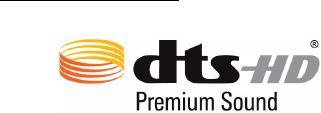
End User License Agreement - 67
TRADEMARK INFORMATION
DTS-HD Premium Sound
For DTS patents, see http://patents.dts.com.
Manufactured under license from DTS Licensing Limited.
DTS, DTS-HD, the Symbol, & DTS or DTS-HD and the
Symbol together are registered trademarks, and DTS-HD
Premium Sound is a trademark of DTS, Inc. © DTS, Inc.
All Rights Reserved.

FCC
Warnings and precautions
Do not use this product near water.
Do not place this product on an unstable cart, stand or table. If the product falls,
it could be seriously damaged.
Slots and openings are provided for ventilation to ensure reliable operation of
the product and to protect it from overheating. These openings must not be
blocked or covered. The openings should never be blocked by placing the
product on a bed, sofa, rug or other similar surface. This product should never
be placed near or over a radiator or heat register, or in a built-in installation
unless proper ventilation is provided.
Never push objects of any kind into this product through cabinet slots as they
may touch dangerous voltage points or short-out parts that could result in a fire
or electric shock. Never spill liquid of any kind onto or into the product.
To avoid damage of internal components and to prevent battery leakage, do not
place the product on a vibrating surface.
Never use this product when engaging in sporting activities, exercising, or in any
vibrating environment which may cause a short circuit or damage, and even a
risk of explosion from the battery pack.
CAUTION when listening to music
To protect your hearing, follow these instructions.
Increase the volume gradually until you can hear clearly and comfortably.
Do not increase the volume level after your ears have adjusted.
Do not listen to music at high volumes for extended periods.
Do not increase the volume to block out noisy surroundings.
Decrease the volume if you can’t hear people speaking near you.
Additional safety information
Your device and its enhancements may contain small parts.
Keep them out of the reach of small children.
Operating environment
---------------------------------------------------------------------------------------------------------
Warning! For safety reasons, turn off all wireless or radio transmitting devices
when using your smartphone device under the following conditions. These
devices may include, but are not limited to: wireless LAN (WLAN), Bluetooth
and/or 3G.
---------------------------------------------------------------------------------------------------------
Remember to follow any special regulations in force in any area, and always switch
off your device when its use is prohibited or when it may cause interference or
danger. Use the device only in its normal operating positions. Do not cover the
antenna with metal and you should position the device at the above-stated distance
from your body. To successfully transmit data files or messages, this device requires a
good quality connection to the network. In some cases, transmission of data files or
messages may be delayed until such a connection is available. Ensure that the above
separation distance instructions are followed until the transmission is completed.
Parts of the device are magnetic.
Metallic materials may be attracted to the device, and persons with hearing aids
should not hold the device to the ear with the hearing aid. Do not place credit cards
or other magnetic storage media near the device, because information stored on
them may be erased.
Medical devices
Operation of any radio transmitting equipment, including wireless phones, may
interfere with the functionality of inadequately protected medical devices. Consult a
physician or the manufacturer of the medical device to determine if they are
adequately shielded from external RF energy or if you have any questions. Switch off
your device in health care facilities when any regulations posted in these areas
instruct you to do so. Hospitals or health care facilities may be using equipment that
could be sensitive to external RF transmissions.
Pacemakers. Pacemaker manufacturers recommend that a minimum separation of
15.3 cm (6") be maintained between wireless devices and a pacemaker to avoid
potential interference with the pacemaker. These recommendations are consistent
with the independent research by and recommendations of Wireless Technology
Research. Persons with pacemakers should do the following:
Always keep the device more than 15.3 cm (6") from the pacemaker.
Not carry the device near your pacemaker when the device is switched on. If
you suspect interference, switch off your device, and move it.
Hearing aids. Some digital wireless devices may interfere with some hearing aids. If
interference occurs, consult your service provider.
Vehicles
RF signals may affect improperly installed or inadequately shielded electronic
systems in motor vehicles such as electronic fuel injection systems, electronic
antiskid (antilock) braking systems, electronic speed control systems, and air bag
systems.
For more information, check with the manufacturer, or its representative. Only
qualified personnel should service the device, or install the device in a vehicle. Faulty
installation or service may be dangerous and may invalidate any warranty that may
apply to the device. Check regularly that all wireless equipment in your vehicle is
mounted and operating properly. Do not store or carry flammable liquids, gases, or
explosive materials in the same compartment as the device, its parts, or
enhancements.
For vehicles equipped with an air bag, remember that air bags inflate with great
force. Do not place objects, including installed or portable wireless equipment in the
area over the air bag or in the air bag deployment area. If in-vehicle wireless
equipment is improperly installed, and the air bag inflates, serious injury could result.
Using your device while flying in aircraft is prohibited. Switch off your device before
boarding an aircraft. The use of wireless tele-devices in an aircraft may be dangerous
to the operation of the aircraft, disrupt the wireless telephone network, and may be
illegal.
Potentially explosive environments
Switch off your device when in any area with a potentially explosive atmosphere and
obey all signs and instructions. Potentially explosive atmospheres include areas
where you would normally be advised to turn off your vehicle engine. Sparks in such
areas could cause an explosion or fire resulting in bodily injury or even death. Switch
off the device at refueling points such as near gas pumps at service stations. Observe
restrictions on the use of radio equipment in fuel depots, storage, and distribution
areas; chemical plants; or where blasting operations are in progress. Areas with a
potentially explosive atmospheres are often, but not always, clearly marked. They
include below deck on boats, chemical transfer or storage facilities, vehicles using
liquefied petroleum gas (such as propane or butane), and areas where the air
contains chemicals or particles such as grain, dust or metal powders. Follow any
restrictions. Do not use the device where blasting is in progress.
Taking care of your smartphone
1. DO take care not to scratch the screen of your smartphone. Keep the screen
clean. When working with your smartphone, use your finger or fingernail. Never
use an actual pen or pencil or other sharp object on the screen surface.
2. DO NOT expose your smartphone to rain or moisture. Do not let water enter the
circuitry through the front panel buttons or expansion slots. In general, treat
your smartphone as you would a mobile phone or other small electronic device.
3. DO be careful not to drop your smartphone or subject it to any strong impact.
Do not place your smartphone in your back pocket.
4. DO NOT expose your smartphone to extreme temperatures. For example, do
not leave your smartphone on the dashboard of a car on a hot day or when
temperatures are below freezing point. Also, keep it away from heaters and
other sources of heat.
5. DO NOT use or store your smartphone in any location that is dusty, damp or
wet.
6. DO use a soft, damp cloth to clean your smartphone. If the surface of the screen
becomes soiled, clean it with a soft cloth moistened with diluted

window-cleaning solution.
7. DO NOT press down on the screen with force, otherwise you may crack the
screen.
LCD pixel statement
The LCD unit is produced with high-precision manufacturing techniques.
Nevertheless, some pixels may occasionally misfire or appear as black or red dots.
This has no effect on the recorded image and does not constitute a malfunction.
Disposal and recycling information
Do not throw this electronic device into the trash when discarding.
To minimize pollution and ensure utmost protection of the global environment,
please recycle. For more information on the Waste from Electrical and Electronics
Equipment (WEEE) regulations, visit
http://www.acer-group.com/public/Sustainability/sustainability01.htm
Mercury advisory
For projectors or electronic products containing an LCD/CRT monitor or display:
Lamp(s) inside this product contain mercury and must be recycled or disposed of
according to local, state or federal laws. For more information, contact the Electronic
Industries Alliance at www.eiae.org. For lamp-specific disposal information, check
www.lamprecycle.org.
RoHS compliance
This product is in compliance with Directive 2011/65/EU of the European Parliament
and of the Council of 8 June 2011, on the restriction of the use of certain hazardous
substances (RoHS) in electrical and electronic equipment and its amendments.
Battery information
This product uses a Lithium Polymer battery. Do not use it in a humid, wet and/or
corrosive environment. Do not put, store or leave your product in or near a heat
source, in a high temperature location, in strong direct sunlight, in a microwave oven
or in a pressurized container, and do not expose it to temperatures over 60 °C (140

°F). Failure to follow these guidelines may cause the battery to leak acid, become hot,
explode or ignite and cause injury and/or damage. Do not pierce, open or
disassemble the battery. If the battery leaks and you come into contact with the
leaked fluids, rinse thoroughly with water and seek medical attention immediately.
For safety reasons, and to prolong the lifetime of the battery, charging will not occur
at low (below 0 °C/32 °F) or high (over 45 °C/113 °F) temperatures.
The full performance of a new battery is achieved only after two or three complete
charge and discharge cycles. The battery can be charged and discharged hundreds of
times, but it will eventually wear out. When the talk and standby times are
noticeably shorter than normal, buy a new battery. Use only Acer approved batteries,
and recharge your battery only with Acer approved chargers designated for this
device.
Unplug the charger from the electrical plug and the device when not in use. Do not
leave a fully charged battery connected to the ac charger, since overcharging may
shorten its lifetime. If left unused, a fully charged battery will lose its charge over
time. If the battery is completely discharged, it may take a few minutes before the
charging indicator appears on the display or before any calls can be made.
Use the battery only for its intended purpose. Never use any charger or battery that
is damaged.
Do not short-circuit the battery. Accidental short-circuiting can occur when a metallic
object such as a coin, clip, or pen causes direct connection of the positive (+) and
negative (-) terminals of the battery. (These look like metal strips on the battery.) This
might happen, for example, when you carry a spare battery in your pocket or purse.
Short-circuiting the terminals may damage the battery or the connecting object.
Leaving the battery in hot or cold places, such as in a closed car in summer or winter
conditions, will reduce the capacity and lifetime of the battery. Always try to keep the
battery between 15 °C and 25 °C (59 °F and 77 °F). A device with a hot or cold battery
may not work temporarily, even when the battery is fully charged. Battery
performance is particularly limited in temperatures well below freezing.
Do not dispose of batteries in a fire as they may explode. Batteries may also explode
if damaged. Dispose of batteries according to local regulations. Please recycle when
possible. Do not dispose as household waste.
Replacing the battery pack
Your smartphone uses lithium batteries. Replace the battery with the same type as
that which came bundled with your product. Use of another battery may present a
risk of fire or explosion.
--------------------------------------------------------------------------------------------------------
Warning! Batteries may explode if not handled properly. Do not disassemble
or dispose of them in fire. Keep them away from children. Follow local
regulations when disposing of used batteries.
------------------------------------------------------------------------------------------------

Prevention of hearing loss
Caution: Permanent hearing loss may occur if earphones or
headphones are used at high volume for prolonged periods of time.
Wireless operation channels for different domains
N. America 2.412-2.462 GHz Ch01 through Ch11
Japan 2.412-2.484 GHz Ch01 through Ch14
Europe ETSI 2.412-2.472 GHz Ch01 through Ch13
List of National Codes
This equipment may be operated in the following countries:
Country ISO 3166
2 letter code
Country ISO 3166
2 letter code
Austria
Belgium
Cyprus
Czech Republic
Denmark
Estonia
Finland
France
Germany
Greece
Hungary
Ireland
Italy
Latvia
Lithuania
Luxembourg
AT
BE
CY
CZ
DK
EE
FI
FR
DE
GR
HU
IE
IT
LV
LT
LU
Malta
Netherlands
Poland
Portugal
Slovakia
Slovenia
Spain
Sweden
United Kingdom
Iceland
Liechtenstein
Norway
Switzerland
Bulgaria
Romania
Turkey
MT
NL
PL
PT
SK
SI
ES
SE
GB
IS
LI
NO
CH
BG
RO
TR
FCC regulations
This device complies with part 15 of the FCC Rules. Operation is subject to the
following two conditions: (1) This device may not cause harmful interference, and (2)
this device must accept any interference received, including interference that may
cause undesired operation.
This device has been tested and found to comply with the limits for a Class B digital
device, pursuant to Part 15 of the FCC Rules. These limits are designed to provide
reasonable protection against harmful interference in a residential installation. This
equipment generates, uses and can radiated radio frequency energy and, if not
installed and used in accordance with the instructions, may cause harmful
interference to radio communications. However, there is no guarantee that
interference will not occur in a particular installation If this equipment does cause
harmful interference to radio or television reception, which can be determined by
turning the equipment off and on, the user is encouraged to try to correct the
interference by one or more of the following measures:
• Reorient or relocate the receiving antenna.
• Increase the separation between the equipment and receiver.
• Connect the equipment into an outlet on a circuit different from that to which
the receiver is connected.
• Consult the dealer or an experienced radio/TV technician for help.
Changes or modifications not expressly approved by the party responsible for
compliance could void the user's authority to operate the equipment.
IC regulations
This device complies with Industry Canada license-exempt RSS standard(s). Operation
is subject to the following two conditions:
(1) this device may not cause interference, and
(2) this device must accept any interference, including interference that may cause
undesired operation of the device.
CAN ICES-3(B)/NMB-3(B)
RF exposure information (SAR)
This device meets the FCC/IC requirements on the limitation of exposure of the
general public to electromagnetic fields by way of health protection.
The unit of measurement for the FCC/IC limit is the "Specific Absorption Rate" (SAR).
The SAR limit set by the FCC/IC is 1.6 W/kg, averaged over 1 g of tissue. The FCC and
IC have granted an Equipment Authorization for this device with all reported SAR
levels evaluated as in compliance with the FCC and IC RF exposure guidelines. SAR
information on this device is on file with the FCC and can be found under the Display
Grant section of www.fcc.gov/oet/ea/fccid after searching on the FCC ID for your
device, which can be found on the product labeling of your device.
For body-worn operation, this device has been tested use with accessories that
contain no metal and that position the handset a minimum of 1.0 cm from the body.
Use of other accessories may not ensure compliance with RF exposure. If you do not
use a body-worn accessory and are not holding the device at the ear, position the
handset a minimum of 1.0 cm from your body when the device is switched on.
During use, the actual SAR level is usually much lower than the maximum value. In
general, the closer you are to a base station, the lower the transmission output of
your device. To reduce exposure to RF energy, use a hands-free accessory or other
similar option to keep this device away from your head and body.

This phone meets the FCC and IC requirements on the limitation of exposure of the
general public to electromagnetic fields by way of health protection.
The highest SAR value of this device is listed below:
FCC (W/kg @1g) IC (W/kg @1g)
Head 0.53 0.53
Body 0.88 0.88
IC French
Avertissements et mises en garde
N’utilisez pas cet appareil près d’une source d’eau.
Ne posez pas cet appareil sur un chariot, un support ou une table instable. S’il
tombe par accident, il pourrait être sérieusement endommagé.
Des fentes et ouvertures sont prévues pour la ventilation afin d’assurer un
fonctionnement fiable de l’appareil et de le protéger d’une éventuelle
surchauffe. Ces ouvertures ne doivent pas être obstruées ou couvertes. Ces
ouvertures ne doivent jamais être bloquées, par exemple en posant l’appareil
sur un lit, un canapé, un tapis ou toute autre surface similaire. Cet appareil ne
doit pas être posé près ou sur un radiateur ou une source de chaleur, ou être
encastré dans une installation, sauf si une ventilation appropriée a été prévue.
N’insérez jamais des objets dans les ouvertures du boîtier de l’appareil, car
ceux-ci pourraient toucher des points à haute tension ou créer un court-circuit
et poser un risque d’incendie ou d’électrocution. Ne renversez jamais de liquide
sur l’appareil.
Pour réduire le risque de dommage interne et pour éviter que la pile ne fuie, ne
posez pas l’appareil sur un endroit sujet à des vibrations.
N’utilisez jamais cet appareil lorsque vous faites du sport, des exercices ou dans
des situations où il risquerait de trembler/d’être secoué, ce qui pourrait
provoquer un court circuit ou des dommages et même un risque d’explosion de
la pile.
ATTENTION lorsque vous écoutez de la musique
Pour protéger votre ouïe, respectez les consignes ci-dessous.
Augmentez le son progressivement jusqu’à ce que vous puissiez l’entendre
nettement et confortablement.
N’augmentez pas le niveau du volume une fois que vos oreilles se sont adaptées
au volume actuel.
N’écoutez pas une musique à un niveau de volume important pendant une
longue durée.
N’augmentez pas le volume pour masquer le bruit environnant.
Baissez le volume si vous ne pouvez pas entendre la personne près de vous.
Consignes de sécurité complémentaires
Votre appareil ainsi que ses accessoires peuvent contenir de petites pièces.
Gardez-les hors de portée des jeunes enfants.
Conditions d’utilisation

---------------------------------------------------------------------------------------------------------
Avertissement ! Pour des raisons de sécurité, éteignez tous les périphériques
de transmission fréquence radio ou sans-fil lorsque vous utilisez votre
téléphone intelligent dans les conditions suivantes. Ces périphériques
peuvent inclure, mais ne sont pas limités à : réseau sans-fil (WLAN),
Bluetooth et/ou 3G.
---------------------------------------------------------------------------------------------------------
Rappelez-vous de respecter toutes les réglementations en vigueur dans votre région,
et éteignez toujours votre appareil quand son utilisation est interdite ou quand il
peut causer des interférences ou présenter un danger. Utilisez l’appareil uniquement
dans ses positions de fonctionnement habituelles. Pour pouvoir transférer les fichiers
de données ou les messages avec succès, cet appareil nécessite une connexion
réseau de bonne qualité. Dans certains cas, le transfert des fichiers de données ou
des messages risque d’être bloqué jusqu’à ce qu’une bonne connexion soit présente.
Assurez-vous de bien respecter les instructions de distance de séparation jusqu’à ce
que le transfert soit terminé. Les composants de cet appareil sont magnétiques.
Les matériaux métalliques peuvent être attirés par l’appareil et les personnes portant
des prothèses auditives ne doivent pas tenir cet appareil à proximité de leurs oreilles.
Ne placez pas de cartes de crédit ou autres médias de stockage magnétiques à
proximité de l’appareil, car les données enregistrées dessus risquent d’être effacées.
Appareils médicaux
L’utilisation de tout équipement de transmission fréquence radio, y compris les
téléphones sans-fil, risque d’interférer avec les fonctionnalités des appareils
médicaux insuffisamment protégés. Consultez un médecin ou le constructeur des
appareils médicaux pour déterminer s’ils sont suffisamment protégés contre
l’énergie de fréquence radioélectrique externe ou si vous avez des questions.
Éteignez votre appareil dans les établissements de soins médicaux en respectant
toutes les réglementations affichées dans ces lieux qui vous imposent de le faire. Les
hôpitaux ou les centres de soins médicaux peuvent utiliser des appareils pouvant
être sensibles aux transmissions de fréquence radioélectrique externes.
Les stimulateurs cardiaques. Les fabricants de stimulateurs cardiaques conseillent de
respecter une distance de séparation minimale de 15,3 cm (6 pouces) entre les
appareils sans-fil et un stimulateur cardiaque pour éviter des éventuelles
interférences avec le stimulateur cardiaque. Ces recommandations sont le fruit de
recherches et de recommandations menées par l’institut Wireless Technology
Research. Les personnes portant un stimulateur cardiaque doivent respecter les
consignes ci-dessous :
Gardez toujours l’appareil à une distance plus de 15,3 cm (6 pouces) du
stimulateur cardiaque.
Ne transportez pas l’appareil près de votre stimulateur cardiaque lorsque
l’appareil est mis sous tension. Si vous soupçonnez une interférence, éteignez
votre appareil et déplacez-le.
Prothèses auditives.Certains appareils sans-fil numériques peuvent interférer avec
certaines prothèses auditives. Si des interférences se produisent, consultez votre
fournisseur.
Véhicules
Les signaux de fréquence radioélectrique risquent d’influencer des systèmes
électroniques mal installés ou insuffisamment protégés dans des véhicules à moteur
comme le système d’injection électronique, le système de freinage avec antiblocage
électronique, le système électronique de contrôle de la vitesse et le système de
coussin gonflable.
Pour de plus amples informations, consultez le constructeur ou son représentant.
Seul un personnel de dépannage qualifié est autorisé à réparer l’appareil ou à
installer l’appareil dans un véhicule. Une installation inappropriée ou un dépannage
incorrect pourrait être dangereux et risque d’invalider la garantie couvrant l’appareil.
Vérifiez régulièrement que tous les équipements sans-fil dans votre véhicule sont
installés et fonctionnent correctement. Ne conservez pas et ne transportez pas de
produits à base de matières liquides inflammables, de produits à base de vapeur ou
de produits explosifs dans le même compartiment où vous rangez cet appareil, ses
composants ou ses accessoires.
En ce qui concerne les véhicules équipés de coussins gonflables, notez bien que les
coussins gonflables se gonflent avec une force très importante. Pour cette raison, ne
placez aucun objet et n’installez aucun équipement sans-fil portable par-dessus ou
dans le rayon de fonctionnement des coussins gonflables. Si un appareil sans-fil pour
véhicule est installé incorrectement et si les coussins gonflables se déclenchent, de
graves blessures peuvent se produire. Il est interdit d’utiliser votre appareil pendant
le vol dans un avion. Éteignez votre appareil avant l’embarquement dans un avion.
L’utilisation des appareils sans-fil dans un avion peut être dangereuse pour le
fonctionnement de l’avion, peut interrompre le réseau de téléphonie et peut être
illégale.
Environnements potentiellement explosifs
Éteignez votre appareil dans toutes les zones présentant une atmosphère
potentiellement explosive et respectez toutes les annonces et consignes. Les
atmosphères potentiellement explosives se trouvent dans les zones où il est
généralement conseillé d’arrêter le moteur de votre véhicule. Des étincelles
pourraient créer des incendies ou des explosions et causer des blessures ou même
entraîner la mort. Éteignez l’appareil dans les endroits à proximité des pompes à
carburant dans les stations essence. Respectez les restrictions concernant l’utilisation
des appareils fréquence radio dans les dépôts, les entrepôts et les zones de
distribution de carburant, les usines de produits chimiques ou dans les endroits en
cours d’opérations de dynamitage. Les zones potentiellement explosives sont
normalement, mais pas toujours, bien marquées. Ces zones comprennent les cales
des bateaux, les installations fixes pour stockage ou transfert des produits chimiques,
les véhicules utilisant des gaz de pétrole liquéfiés (comme le propane ou le butane)
et les zones dans lesquelles l’air contient des substances chimiques ou des particules
comme des grains, de la poussière ou des poudres métalliques. Respectez toutes les
restrictions. N’utilisez pas l’appareil dans un endroit en cours de dynamitage.
Entretien de votre téléphone intelligent
1. FAITES attention à ne pas rayer l’écran de votre téléphone intelligent. Gardez
toujours l’écran propre. Quand vous travaillez avec votre téléphone intelligent,
utilisez votre doigt ou votre ongle. N’utilisez jamais un stylo normal ou un
crayon ou tout autre objet pointu pour taper sur la surface de l’écran.
2. N’exposez PAS votre téléphone intelligent à la pluie ou à l’humidité. Ne laissez
pas de l’eau entrer dans les circuits via les boutons du panneau frontal,
connecteurs ou les logements de carte. En général, traitez votre téléphone
intelligent comme un téléphone cellulaire ou un appareil électronique fragile.
3. FAITES attention à ne pas faire tomber votre téléphone intelligent ou le
soumettre à des chocs violents. Ne gardez pas votre téléphone intelligent dans
une poche arrière.
4. N’exposez PAS votre téléphone intelligent à des températures extrêmes. Par
exemple, ne laissez pas votre téléphone intelligent sur le tableau de bord d’une
voiture en plein soleil ou lorsque la température est moins de zéro. Faites aussi
attention aux chauffages et sources de chaleurs.
5. N’utilisez ou ne gardez PAS votre téléphone intelligent dans un endroit
poussiéreux, humide ou mouillé.
6. FAITES attention à n’utiliser qu’un chiffon doux et légèrement mouillé pour
nettoyer votre téléphone intelligent. Si la surface de l’écran est sale, nettoyez-la
avec un chiffon doux légèrement mouillé avec une solution détergente pour
fenêtre.
7. N’appuyez PAS sur l’écran avec une force brute, autrement vous pourriez le
casser.
Appels d’urgence
Important : Les téléphones sans-fil, y compris cet appareil, fonctionnent en utilisant
des signaux radio, des réseaux sans-fil, des réseaux câblés ou des fonctions
programmées par un utilisateur. De ce fait, une connexion dans toutes les situations
ne peut pas être garantie. Vous ne devez jamais compter trop sur un appareil sans-fil
pour les communications importantes comme les urgences médicales.
Pour effectuer un appel d’urgence :
1. Si l’appareil est éteint, allumez-le. Vérifiez que la puissance du signal est
adéquate. Certains réseaux peuvent exiger qu’une carte SIM soit présente dans
l’appareil.
2. Appuyez le bouton Fin autant de fois que nécessaire pour effacer l’écran et
préparer l’appareil pour les appels.
3. Entrez le numéro d’urgence officiel pour votre position actuelle. Les numéros

d'urgence varient selon les lieux.
4. Appuyez le bouton Appel.
Si certaines fonctions sont utilisées, vous devrez peut être éteindre ces fonctions
avant de pouvoir passer un appel d’urgence. Consultez ce guide ou votre opérateur
pour plus d’informations.
Lorsque vous passez un appel d’urgence, donnez toutes les informations nécessaires,
aussi clairement que possible. Il est possible que votre appareil-sans fil soit le seul
appareil de communication disponible sur le site d’un accident. Ne terminez pas
l’appel jusqu’à ce que l’on vous le permette.
Déclaration sur les pixels ACL
L’écran ACL de l’appareil est fabriqué avec des méthodes industrielles de haute
précision. Néanmoins, des pixels peuvent de temps en temps disparaître ou
apparaître comme des points noirs ou rouge. Ceci n’a aucun effet sur l’image
enregistrée et n’est pas un dysfonctionnement.
Informations de déchet et de recyclage
Ne jetez pas cet appareil électronique dans la poubelle lorsque vous vous en
débarrassez.
Pour minimiser la pollution et assurer la protection de l’environnement, veuillez
recycler. Pour plus d’information sur les réglementations sur les déchets
d’équipements électriques et électroniques (DEEE), visitez
http://www.acer-group.com/public/Sustainability/sustainability01.htm
Avis sur le Mercure
Pour les projecteurs ou les équipements électroniques équipés d’un moniteur ou
affichage ACL/cathodique :
Les lampes à l’intérieur de cet équipement contiennent du mercure et doivent être
recyclées ou détruites conformément aux lois locales, d’état ou fédérales. Pour plus
d’informations, veuillez contacter l’alliance des industries électroniques
sur www.eiae.org. Pour des informations de mise au rebut spécifiques aux lampes,
visitez
www.lamprecycle.org.
Conformité RoHS
Ce produit est conforme à la Directive 2011/65/EU du Parlement Européen et du
Conseil du 8 juin 2011, relative à la limitation de l’utilisation de certaines substances
dangereuses (RoHS) dans les équipements électriques et électroniques et ses
amendements.
Informations sur la pile
Ce produit utilise une pile au lithium-polymère. Ne l’utilisez pas dans des endroits
humides, mouillés et/ou corrosifs. Ne placez pas, ne stockez pas et ne laissez pas
votre produit dans ou à proximité d’une source de chaleur, dans un lieu à
température élevé, dans la lumière directe du soleil, dans un four micro-ondes ou
dans un conteneur pressurisé, et ne l’exposez pas à des températures supérieures à
60 °C (140 °F). Le non-respect de ces règles peut causer une fuite d’acide de la pile,
sa surchauffe, son explosion ou son inflammation et causer des blessures et/ou des
dommages. Ne percez pas, n’ouvrez pas et démontez pas la pile. Si la pile fuit et si
vous êtes en contact avec des liquides de la pile, rincez abondamment avec de l’eau
et consultez un médecin immédiatement. Pour des raisons de sécurité, et pour
prolonger l’autonomie de la pile, la charge ne se produira pas à des températures
basses (moins de 0 °C/32 °F) ou hautes (plus de 45 °C/113 °F).
La pleine performance d’une nouvelle pile est atteinte seulement après deux ou trois
cycles complets de charge et de décharge. La pile peut être chargée et déchargée des
centaines des fois, mais éventuellement elle s’usera. Lorsque les durées de
conversation et de veille sont beaucoup plus courtes qu’à l’habitude, achetez une
nouvelle pile. N’utilisez que des piles homologuées par Acer, ne rechargez votre pile
qu’avec des adaptateurs homologués par Acer pour cet appareil.
Débranchez le chargeur de la prise électrique et de l’appareil lorsqu’il n’est pas utilisé.
Ne laissez pas une pile complètement chargée connectée à l’adaptateur c.a., car une
surcharge peut réduire sa durée de vie. Une pile, lorsqu’elle n’est pas utilisée, se
déchargera petit à petit. Si une pile est complètement déchargée, l’indicateur de
charge qui s’affiche sur l’écran peut prendre plusieurs minutes avant d’apparaître, et
aucun appel ne pourra être effectué pendant cette période.
N’utilisez cette pile que pour le but à laquelle elle est destinée. N’utilisez jamais de
chargeur ou de pile qui serait endommagé.
Ne court-circuitez pas la pile. Un court-circuit accidentel peut se produire lorsqu’un
objet métallique, tel qu’une pièce de monnaie, un trombone ou un stylo cause une
connexion directe des bornes positive (+) et négative (-) de la pile. (Ce sont des
bandes de métal sur la pile.) Ceci peut se produire, par exemple, lorsque vous avez
une pile de rechange dans votre poche ou votre sac. Le court-circuit des bornes peut
endommager la pile ou l’objet connectant.
La capacité et l’autonomie de la pile sera réduite si la pile est laissée dans un endroit
chaud ou froid, tel qu’une voiture fermée en été ou en hiver. Essayez de toujours
conserver la pile entre 15 °C et 25 °C (59 °F et 77 °F). Un appareil avec une pile
chaude ou froide peut ne pas fonctionner temporairement, même si la pile est
pleinement chargée. La performance de la pile est particulièrement limitée dans des
températures inférieures à 0°C.
Ne jetez pas les piles dans un feu, car elles peuvent exploser. Les piles peuvent

également exploser si elles sont endommagées. Mettez les piles au rebut en respect
avec la réglementation locale. Si possible, veuillez les recycler. Ne les jetez pas avec
les déchets domestiques.
Remplacer la pile
Votre téléphone intelligent utilise des piles au lithium. Remplacez la pile par une pile
du même type que celle fournie avec votre appareil. Une pile d’un autre type peut
poser un risque d’incendie ou d’explosion.
--------------------------------------------------------------------------------------------------------
Avertissement ! Les piles incorrectement manipulées risquent d’exploser.
Vous ne devez jamais les démonter, ni les exposer au feu. Éloignez-les des
enfants. Respectez la réglementation locale pour mettre au rebut les piles
usagées.
------------------------------------------------------------------------------------------------
Prévenir la perte auditive
Attention : Une perte auditive permanente peut se produire si des
écouteurs ou des casques sont utilisés à un volume élevé pendant de
longues périodes de temps.
Canaux d’opération sans-fil pour différents domaines
Canada 2,412-2,462 GHz Canal 01 à Canal 11
Japon 2,412-2,484 GHz Canal 01 à Canal 14
Europe ETSI 2,412-2,472 GHz Canal 01 à Canal 13
Liste de codes nationaux
Cet appareil peut être utilisé dans les pays suivants :
Pays ISO 3166
Code à 2 lettres
Pays ISO 3166
Code à 2 lettres
Autriche
Belgique
Chypre
République Tchèque
Danemark
Estonie
Finlande
France
Allemagne
Grèce
Hongrie
Irlande
AT
BE
CY
CZ
DK
EE
FI
FR
DE
GR
HU
IE
Malte
Pays Bas
Pologne
Portugal
Slovaquie
Slovénie
Espagne
Suède
Royaume-Uni
Islande
Liechtenstein
Norvège
MT
NL
PL
PT
SK
SI
ES
SE
GB
IS
LI
NO

Italie
Lettonie
Lituanie
Luxembourg
IT
LV
LT
LU
Suisse
Bulgarie
Roumanie
Turquie
CH
BG
RO
TR
Règlements IC
Cet appareil est conforme aux normes CNR exemptes de licence d’Industrie Canada.
Le fonctionnement est subordonné aux deux conditions suivantes :
(1) cet appareil ne doit pas provoquer d’interférences, et
(2) cet appareil doit accepter toute interférence, y compris des interférences qui
peuvent provoquer un fonctionnement non désiré de l’appareil.
CAN ICES-3(B)/NMB-3(B)
Informations sur l’exposition à la radiofréquence (DAS)
Cet appareil est conforme aux exigences d’IC sur la limitation d’exposition du public
général aux champs électromagnétiques pour protéger la santé.
L’unité de mesure de la limite recommandée par IC est le « débit d’absorption
spécifique » (DAS). La limite DAS définie par IC est 1,6 W/kg, sur une moyenne de 1 g
de peau. IC a accordé une autorisation d’équipement pour ce modèle d’appareil avec
tous les niveaux de DAS indiqués comme respectant les recommandations
d’exposition RF d’IC.
Pour l’utilisation sur le corps, cet appareil a été testé pour une utilisation avec des
accessoires ne contenant aucun métal et qui positionnent l’appareil au minimum à
1,0 cm du corps. L’utilisation d’autres accessoires peut ne pas assurer la conformité à
l’exposition à la radiofréquence. Si vous n’utilisez pas un accessoire porté sur le corps
et ne tenez pas l’appareil à l’oreille, positionnez l’appareil au minimum à 1,0 cm du
corps lorsque le téléphone est allumé.
Pendant l’utilisation, le niveau DAS est bien inférieur à la valeur maximale. En général,
plus vous êtes proche de la station de base, plus la sortie de transmission de votre
appareil est faible. Pour réduire l’exposition à l’énergie de radiofréquence, utilisez un
accessoire mains libres ou une autre option similaire pour éloigner cet appareil de
votre tête et de votre corps.
Ce téléphone est conforme aux exigences d’IC sur la limitation d’exposition du public
général aux champs électromagnétiques pour protéger la santé.
La valeur DAS la plus élevée de cet appareil est listée ci-dessous :
IC (W/kg à 1g)
Tête 0.53
Corps 0.88